new posts in all blogs
Viewing: Blog Posts Tagged with: 2016 picture books, Most Recent at Top [Help]
Results 1 - 13 of 13
How to use this Page
You are viewing the most recent posts tagged with the words: 2016 picture books in the JacketFlap blog reader. What is a tag? Think of a tag as a keyword or category label. Tags can both help you find posts on JacketFlap.com as well as provide an easy way for you to "remember" and classify posts for later recall. Try adding a tag yourself by clicking "Add a tag" below a post's header. Scroll down through the list of Recent Posts in the left column and click on a post title that sounds interesting. You can view all posts from a specific blog by clicking the Blog name in the right column, or you can click a 'More Posts from this Blog' link in any individual post.

By:
Betsy Bird,
on 10/11/2016
Blog:
A Fuse #8 Production
(
Login to Add to MyJacketFlap)
JacketFlap tags:
Reviews,
Best Books,
Anne Herbauts,
French children's books,
Enchanted Lion Books,
French picture books,
translated picture books,
international children's books,
Best Books of 2016,
2016 imports,
2016 picture books,
2016 reviews,
Reviews 2016,
2016 translated children's books,
Add a tag
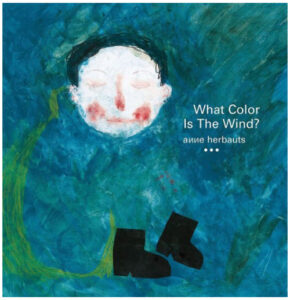 What Color Is the Wind?
What Color Is the Wind?
By Anne Herbauts
Translated by Claudia Zoe Bedrick
Enchanted Lion Books
$19.95
ISBN: 978-1-59270-221-3
Ages 5 and up
On shelves now
I’m going to have a hard time of it when my kids grow up. When I had them I swore up, down and sideways that I wouldn’t turn into the kind of blogger that declares that a book is good or bad, based solely on the whims of my impertinent offspring. For the most part, I’ve kept that promise. I review picture books outside of their influence, though I’m always interested in their opinions. Indeed, these opinions, and the sharp eyes that inform them, are sometimes not what I’d expect at all. So while I’ve never changed my opinion from liking a book to not liking it just because it didn’t suit my own particular kids’ tastes, I have admittedly found a new appreciation for other books when the children were able to spot things that I did not. What Color Is the Wind? is a pretty good example of this. I read the book at work, liked it fine, and brought it home for a possible review. My daughter then picked it up and proceeded to pretty much school me on what it contained, front to finish. Had I noticed the Braille on the cover? No. Did I see that the main character’s eyes are closed the whole time? No. How about the tactile pages? Did you notice that you can feel almost all of them? No. For a book that may look to some readers as too elegant and sophisticated to count as a favored bedtime story, think again. In this book Anne Herbauts proves beyond a shadow of a doubt that a distinct European style is engaging to American children when their parents give it half a chance. Particularly when tactile elements are involved.
 “We can’t see the wind, / we hear what it brings. / We can’t hear the wind, / we see what it brings.” The book begins with a question. A boy, his eyes closed, walks behind the cutout of a house. “What color is the wind? asks the little giant.” As he walks along, various plants, birds, animals, and inanimate objects offer answers. A wolf says the wind’s color is “the dark smell of the forest” while a window disagrees and says it’s “the color of time.” Everything that answers the little giant has a different feel on the page. The stream feels like consecutive ripples emanating from a dropped pebble, the roots of an apple tree like long, thin rivulets. At last the little giant encounters something that he senses is enormous. He asks his question and an enormous giant replies, “It is everything at once. This whole book.” He flips the book’s pages with his thumb so that they fly, and you the reader do the same, feeling the wind the book is capable of producing with its thick, lustrous pages. The color of the wind. The wind of this book.
“We can’t see the wind, / we hear what it brings. / We can’t hear the wind, / we see what it brings.” The book begins with a question. A boy, his eyes closed, walks behind the cutout of a house. “What color is the wind? asks the little giant.” As he walks along, various plants, birds, animals, and inanimate objects offer answers. A wolf says the wind’s color is “the dark smell of the forest” while a window disagrees and says it’s “the color of time.” Everything that answers the little giant has a different feel on the page. The stream feels like consecutive ripples emanating from a dropped pebble, the roots of an apple tree like long, thin rivulets. At last the little giant encounters something that he senses is enormous. He asks his question and an enormous giant replies, “It is everything at once. This whole book.” He flips the book’s pages with his thumb so that they fly, and you the reader do the same, feeling the wind the book is capable of producing with its thick, lustrous pages. The color of the wind. The wind of this book.
The Kirkus review journal said that this book was, “ ‘The blind men and the elephant’ reworked into a Zen koan” and then proceeded to recommend it for 9-11 year-olds and adults. I’m fairly certain I disagree with almost every part of that. Now here’s the funny part. I didn’t read this review before I read the book. I also didn’t read the press release that was sent to me with it. When I read a book I like to be surprised by it in some way. This is usually a good thing, but once in a while I can be a bit dense and miss the bigger picture. As I mentioned before, I completely missed the fact that this book was an answer to a blind child who had asked Anne Herbauts the titular question. I just thought it was cool that the book was so much fun to touch. Embossing, debossing, die-cuts, lamination, and all kinds of surfaces give the book the elements that make it really pop. As I read it in the lunchroom at work, my co-workers would peer over my shoulders to coo at what they saw. All well and good, but would a kid be interested too? Kirkus says they’d have to be at least nine to grasp its subtleties.
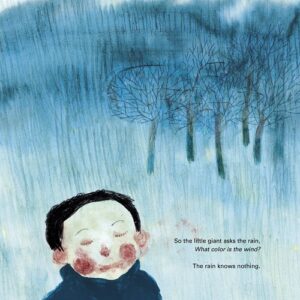 Obviously my 5-year-old daughter likes the book but she’s just one kid. She is not a representative for her species (so to speak). That said, this book just drills home the advantage that physical books have over their electronic counterparts: the sensation of touch. Play with a screen all day if you like, but you will never be able to move your fingers over these raised dots of rain or the rough bark of a tree’s trunk. As children become more immersed in the electronic, they become more enamored of tactile books. The sensation of paper on skin has yet to be replicated by our smooth as silk screens. And this will prove true with kids on the younger end of the scale. I’ll agree with Kirkus about the adult designation, though. When I worked for New York Public Library there was a group of special needs adults that would come in that were in need of tactile picture books. We would be asked if we had any on hand that we could hand over to them in some way. There were a few, but our holdings were pretty limited (though I do remember a particularly keen tactile version of The Very Hungry Caterpillar that proved to be a big hit). Those kids would have loved this book, but children of all ages, and all abilities, would feel the same way about it. Kids are never too old for tactile picture books. As such, you could use this book with Kindergartners as well as fifth graders. Little kids will like the fun pictures. Older kids may be inspired by the words as well.
Obviously my 5-year-old daughter likes the book but she’s just one kid. She is not a representative for her species (so to speak). That said, this book just drills home the advantage that physical books have over their electronic counterparts: the sensation of touch. Play with a screen all day if you like, but you will never be able to move your fingers over these raised dots of rain or the rough bark of a tree’s trunk. As children become more immersed in the electronic, they become more enamored of tactile books. The sensation of paper on skin has yet to be replicated by our smooth as silk screens. And this will prove true with kids on the younger end of the scale. I’ll agree with Kirkus about the adult designation, though. When I worked for New York Public Library there was a group of special needs adults that would come in that were in need of tactile picture books. We would be asked if we had any on hand that we could hand over to them in some way. There were a few, but our holdings were pretty limited (though I do remember a particularly keen tactile version of The Very Hungry Caterpillar that proved to be a big hit). Those kids would have loved this book, but children of all ages, and all abilities, would feel the same way about it. Kids are never too old for tactile picture books. As such, you could use this book with Kindergartners as well as fifth graders. Little kids will like the fun pictures. Older kids may be inspired by the words as well.
“Mom,” said my daughter as we went down the stairs for her post-reading, pre-brushing, nighttime snack. “Mom, you know the wind doesn’t have a color, right?” My child is a bit of a literalist. She’s the kid who knew early on that magic wasn’t real and once told me at the age of three that, “If ‘please’ is a magic word, it doesn’t exist.” So to read an entire book, based on the premise of seeing a color that couldn’t possibly be real, was a stretch for her. Remember, we read this entire book without really catching on that the little giant was blind. I countered that it was poetry, really. Colors were just as much about what they looked like as what they felt like. I asked her what blue made her feel, and red. Then I applied that to the emotions we feel about with the wind, which wasn’t really an analogy that held much water, but she was game to hear me out. “It’s poetry”, I said again. “Words that make you feel something when you read them.” So, as she had her snack, she had me read her some poetry. We’ve been reading poetry with her snack every night since. So for all that the book could be seen to be a straightforward picture book, to me it’s as much an introduction to poetry as anything else.
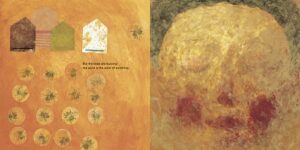
As for the art, I’ll admit that the combination of the style of art, the image on the cover, and the fact that the book is softcover and not hardcover (a cost-saving measure for what must be a very expensive title for Enchanted Lion Books to publish) did not immediately appeal to me. There’s no note to explain what the medium is and if I were to guess I’d say we were looking at crayons, mixed media, thick paints, colored pencils, ink blots, pen-and-inks, and more. Ironically, I really began to gravitate to the art when the little giant wasn’t stealing my focus. Nothing is intricately detailed, except perhaps the anatomy of honeybees or the raised and bumpy parts of the book. At the same time, for a book that celebrates touch, poetry, and physical sensation, the colors are often bright and lush. Whether it’s the blue watercolors of rain over trees or the hot orange that emanates from the page like a sun, Herbauts is simultaneously rendering illustrations obsolete with the unique format of What Color is the Wind? and celebrating their visual extremes.
I tend to give positive reviews to books that exceed my expectations. That’s just the nature of my occupation. And while I do believe that there are elements to this book that could be clearer or that there must have been a book jacket choice they could have chosen that was more appealing than the one you see here, otherwise I think this little book is a bit of a wonder. Deeply appealing to children of all ages, to say nothing of the adults out there, with so many uses, and so many applications. It reminds me of the old picture books by Bruno Munari that weren’t afraid to try new things with the picture book format. To get a little crazy. I don’t think we’ll suddenly see a big tactile picture book craze sweep the nation or anything, but maybe this book will inspire just one other publisher to try something a little different and to take a risk. Could be worth it. There’s nothing else like this book out there today. More’s the pity.
On shelves now.
Source: Final edition sent from publisher for review.
Like This? Then Try:
Professional Reviews:
Misc: A deeper look at some of the art over at Seven Impossible Things Before Breakfast


By:
Betsy Bird,
on 9/20/2016
Blog:
A Fuse #8 Production
(
Login to Add to MyJacketFlap)
JacketFlap tags:
Reviews,
picture books,
Chronicle,
Best Books,
Brendan Wenzel,
picture book readalouds,
Best Books of 2016,
2016 picture books,
2016 reviews,
Reviews 2016,
2017 Caldecott contenders,
2016 picture book readalouds,
Add a tag
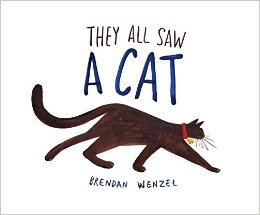 They All Saw a Cat
They All Saw a Cat
By Brendan Wenzel
Chronicle Books
$16.99
ISBN: 978-1-4521-5013-0
Ages 4-7
On shelves now
It’s funny. Unless you’re a teacher or librarian, a grown adult that does not work or live with children will come into very little contact with picture books. Then, one day, they produce a few kids and BLAMMO! They are shot into a world they haven’t visited since they were young themselves. They grab frantically at the classics, discover that a lot of them don’t work with very very young children (since when did Horton Hatches the Egg have so many words?!?), and then occasionally turn to the experts for help. And why? Parents’ reasons are not united on this front. Some read to their kids to instill a love of reading. Others to build little brains. Others to simply fill the long hours of the day. Occasionally a parent will also use a book to teach some kind of a lesson. If the parent is unlucky they will get stuck with a book sticky with didacticism (an unpleasant book that sucks all the joy out of the reading experience). But if they are lucky (or they are in the hands of a capable professional) they might find just the right book, teaching just the right lesson. Here’s an example: Let’s say you wanted to teach a kid empathy or how our perceptions change depending on our own experiences and who we are. How do you show that in 32 pages? Well, you could pick up some cloying, toxic dribble that overuses words like “hugs” and “friendship”. Nine times out of ten, that’s what’s going to happen. Or, if you are a clever parent, you pick up a book like They All Saw a Cat. It looks at first glance like it’s just about a cat. Delve a little deeper and you’ll find it about science and art and perception and empathy. And it does it all with very simple sentences, repetition, and a lot of white backgrounds. Not too shabby. Not too shabby at all.
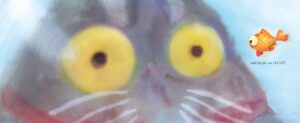 “The cat walked through the world, with its whiskers, ears, and paws . . .” In that walking it is seen. It is seen by a child, a dog, and a fox. It is seen by a fish, a mouse, and a bee. It is seen by a bird, a flea, a snake, a skunk, a worm, and a bat. And what’s important is that this “seeing” changes with every creature. For mice and dogs, the cat is perceived through the lens of their own interactions with it. For worms and bats the cat is only visible through the ways in which it moves through space (vibrations through the ground and the ways in which echolocation shape it). By the end we see a hodgepodge cat, a mix of how each animal sees it. Then the cat comes to the water, viewing its own reflection, “and imagine what it saw?”
“The cat walked through the world, with its whiskers, ears, and paws . . .” In that walking it is seen. It is seen by a child, a dog, and a fox. It is seen by a fish, a mouse, and a bee. It is seen by a bird, a flea, a snake, a skunk, a worm, and a bat. And what’s important is that this “seeing” changes with every creature. For mice and dogs, the cat is perceived through the lens of their own interactions with it. For worms and bats the cat is only visible through the ways in which it moves through space (vibrations through the ground and the ways in which echolocation shape it). By the end we see a hodgepodge cat, a mix of how each animal sees it. Then the cat comes to the water, viewing its own reflection, “and imagine what it saw?”
The book this actually reminded me of the most was that old Rudyard Kipling story “The Cat Who Walked By Himself”. Unlike that tale we never really get this book from the cat’s perspective. Indeed, the cat is often only visible when others see him. The similarity to Kipling comes with the language. That very first sentence, for example: “The cat walked through the world, with its whiskers, ears, and paws . . .” And as in the original art for that story, the cat here is often pictured from the back. There’s a lot of debate about whether or not a book written by one person and illustrated by another can ever be as strong as a book that is written and illustrated by the same artist. They All Saw a Cat makes a fairly strong argument that artist who are also authors are the better way to go. Wenzel’s sentences are so perfectly layered here. If anything, they match the personality of a cat. There aren’t many words, true. But the measured tone is at once soothing and scintillating. I liked how the book broke up the animals. The first three are potential predators. The second three are potential  prey. The final six are strict observers. It also ends perfectly with the best possible sentence. Not all picture books, no matter how beautiful they look, are capable of sticking their landings. This one does.
prey. The final six are strict observers. It also ends perfectly with the best possible sentence. Not all picture books, no matter how beautiful they look, are capable of sticking their landings. This one does.
In this book the publication page (where they tend to describe the artist’s process) gets a little slaphappy. It reads (and I am quoting this precisely), “The illustrations in this book were rendered in almost everything imaginable, including colored pencil, oil pastels, acrylic paint, watercolor, charcoal, Magic Marker, good old number 2 pencils, and even an iBook.” The other day I was listening to a podcast where one of the speakers speculated that including this kind of information in a book changes the adult reader’s perspective. Would I think less of this book if I found out it was done in digital ink? Possibly, though I should note that I was blown away by the art long before I ever turned to see how it was made. And while digital art is great and has its place, I’d like to see the program that replicates what Wenzel’s done here.
 The sheer beauty of the book is what strikes you first when you read it. Consider the two-page spread where on the left-hand side you see the cat through snake vision, and on the right-hand side you see the cat through skunk vision. The snake’s view is a vibrant shock of color, all yellows and reds and blues. The skunk’s in contrast, looks like the soft grainy sepia-tones of an old film. Maybe Casablanca. Put together, side-by-side, the same cat is its own opposite. But if Wenzel were constantly wowing you with eye-popping images that wouldn’t really support the narrative flow. That’s why the pacing of the book is key. Wenzel starts the book out very slowly, with lots of white backgrounds and views akin to what we see as people. The child, dog, and fox all see the cat similarly (though I loved the oversized bell around its neck, indicating the fox and dog’s superior sense of hearing through a visual medium). The fish is the first moment you start to separate from human visuals. The cat’s large, yellow eyes are 80% of the two pages. But it is the mouse’s Basquiat-esque view of the cat that steals the show. The red background, and the cat all teeth and claws, and terrifying eyes is a far cry from the cuddly creature at the start of the story. It’s also the moment when the child readers come to realize that perception is personal.
The sheer beauty of the book is what strikes you first when you read it. Consider the two-page spread where on the left-hand side you see the cat through snake vision, and on the right-hand side you see the cat through skunk vision. The snake’s view is a vibrant shock of color, all yellows and reds and blues. The skunk’s in contrast, looks like the soft grainy sepia-tones of an old film. Maybe Casablanca. Put together, side-by-side, the same cat is its own opposite. But if Wenzel were constantly wowing you with eye-popping images that wouldn’t really support the narrative flow. That’s why the pacing of the book is key. Wenzel starts the book out very slowly, with lots of white backgrounds and views akin to what we see as people. The child, dog, and fox all see the cat similarly (though I loved the oversized bell around its neck, indicating the fox and dog’s superior sense of hearing through a visual medium). The fish is the first moment you start to separate from human visuals. The cat’s large, yellow eyes are 80% of the two pages. But it is the mouse’s Basquiat-esque view of the cat that steals the show. The red background, and the cat all teeth and claws, and terrifying eyes is a far cry from the cuddly creature at the start of the story. It’s also the moment when the child readers come to realize that perception is personal.
An interesting criticism of this book is linked precisely to the more science-y aspects of the text. One of the commenters on a blog post I wrote, that included this book, said that, “I desperately wanted some nice science-y back matter to tell us how and why different animals see the cat the way they do. Sure, we can go OH, this animal must be colorblind! This animal ‘sees’ by sonar! But c’mon, throw us an edu-bone here. It felt like such a missed opportunity.” This is an interesting note. We’ve grown used to useful backmatter in this post-Core Curriculum world of ours. Would this book have been stronger if it had contained a science element to it? Yes and no. It would have been a real boon to teachers, you betcha, and probably to perceptive parents who could have turned it into a lesson for young readers. If I had to guess I’d say the reason it wasn’t done may have had something to do with the fact that Wenzel is mixing his fact and fiction here pretty closely. Each animal is “seeing” as it would in the wild, but that is not to say that the art is by any means scientific. The cartoonish quality to the animals (no better exemplified than in the mouse’s bulbous eyes) doesn’t hold up to close scrutiny. I would have very much liked notes on the accuracy of the art, but I can understand the fear of asking the reader to take the work too seriously. I don’t necessarily agree, but I understand it.
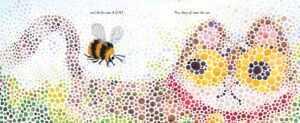 How do you discuss this book with kids? Well, you might read it to them, start to finish, and then ask them which picture shows what the cat really looks like. When they select (some will go with the human view but I’ve no doubt a couple will prefer the dog or bird p.o.v.s) you then tell them that actually all the pictures in this book are true. And if you really want to blow their little minds, you tell them that there’s a good chance that the way you see the world isn’t the same way the person next to you does. Everyone, everywhere sees the world different from his or her neighbor. Is it any wonder we have problems? The solution is to try and see things from another person’s view. Now, if the kids think you’re speaking literally or figuratively, it doesn’t really matter. You’ve planted the seed. Or, rather, the book has.
How do you discuss this book with kids? Well, you might read it to them, start to finish, and then ask them which picture shows what the cat really looks like. When they select (some will go with the human view but I’ve no doubt a couple will prefer the dog or bird p.o.v.s) you then tell them that actually all the pictures in this book are true. And if you really want to blow their little minds, you tell them that there’s a good chance that the way you see the world isn’t the same way the person next to you does. Everyone, everywhere sees the world different from his or her neighbor. Is it any wonder we have problems? The solution is to try and see things from another person’s view. Now, if the kids think you’re speaking literally or figuratively, it doesn’t really matter. You’ve planted the seed. Or, rather, the book has.
Let us do away with the notion of “cat people” vs. “dog people”. This book is for “people”. End of sentence. And if I got a little crazy in my first paragraph here, filling you in on my view of world peace via picture books, you’ll understand when you read this book. That tired old phrase to “walk a mile in someone else’s shoes” makes no sense to a kid. But travel a page through another animal’s eyes? There’s never been a better fictional picture book that allows you to do this. If we all see something as simple as a cat this differently, what else might we not see the same? It’s a treat to eye, ear, and mind, but don’t forget. We’re all going to see this book through our own lenses. What will your kids see when they look at it? Only one way to find out.
On shelves now.
Source: Galley sent from publisher for review.
Like This? Then Try:
Professional Reviews:
Other Mentions:
Videos:


By:
Betsy Bird,
on 8/24/2016
Blog:
A Fuse #8 Production
(
Login to Add to MyJacketFlap)
JacketFlap tags:
Canadian picture books,
picture book readalouds,
2016 picture books,
2016 reviews,
Reviews 2016,
2016 picture book readalouds,
Reviews,
picture books,
Canadian children's books,
Tundra Books,
Bill Slavin,
Add a tag
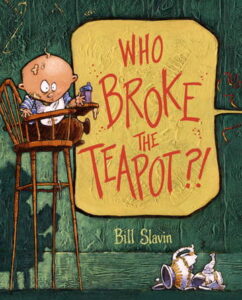 Who Broke the Teapot?!
Who Broke the Teapot?!
By Bill Slavin
Tundra Books
$16.99
ISBN: 978-1-77049-833-4
Ages 3-5
On shelves now
In the average life of a child, whodunits are the stuff of life itself. Who took the last cookie? Who used up all the milk and then didn’t put it on the shopping list? Who removed ALL the rolls of toilet paper that I SPECIFICALLY remember buying at the store on Sunday and now seem to have vanished into some toilet paper eating inter-dimension? The larger the family, the great the number of suspects. But picture books that could be called whodunits run a risk of actually going out and teaching something. A lesson about honesty or owning up to your own mistakes. Blech. I’ll have none of it. Hand me that copy of Bill Slavin’s Who Broke the Teapot?! instead, please. Instead of morals and sanctity I’ll take madcap romps, flashbacks, and the occasional livid cat. Loads of fun to read aloud, surprisingly beautiful to the eye, and with a twist that no one will see coming, Who Broke the Teapot?! has it all, baby. Intact teapot not included.
The scene of the crime: The kitchen. The family? Oblivious. As the mother enters the room it’s just your average morning. There’s a baby in a high chair, a brother attached to a ceiling fan by his suspenders, a dad still in his underwear reading the paper, a daughter eating pastries, a dog aiding her in this endeavor, and a cat so tangled up in wool that it’s a wonder you can still make out its paws. And yet in the doorway, far from the madding crowd, sits a lone, broken, teapot. Everyone proclaims innocence. Everyone seems trustworthy in that respect. Indeed, the only person to claim responsibility is the baby (to whom the mother tosses a dismissive, “I doubt it”). Now take a trip back in time just five minutes and all is revealed. The true culprit? You’ll have to read the book yourself. You final parting shot is the mother accepting a teapot stuck together with scotch tape and love from her affectionate offspring.
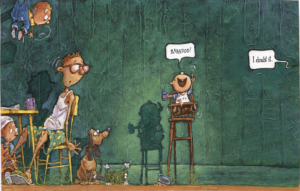 Generally when I write a picture book review I have a pretty standard format that I adhere to. I start with an opening paragraph (done), move on to a description of the plot in the next paragraph (so far, so good), and in the third paragraph I talk about some aspect of the writing. It could be the overall theme or the writing or the plotting. After that I talk about the art. This pattern is almost never mucked with . . . until today!! Because ladies and gents, you have just GOT to take a gander at what Mr. Slavin’s doing here with his acrylics. Glancing at the art isn’t going to do it. You have to pick this book up and really inspect the art. For the bulk of it the human characters are your usual cartoony folks. Very smooth paints. But even the most cursory glance at the backgrounds yields rewards. The walls are textured with thick, luscious paints adhering to different patterns. There’s even a touch of mixed media to the old affair, what with cat’s yarn being real thread and all (note too how Slavin seamlessly makes it look as if the yarn is wrapped around the legs of the high chair). Then the typography starts to get involved. The second time the mom says “Who broke the teapot?!” the words look like the disparate letters of a rushed ransom note. As emotions heat up (really just the emotions of the mom, to be honest) the thick paints crunch when she says “CRUNCHED”, acquire zigzags as her temper unfurls, and eventually belie the smoothness of the characters’ skin when the texture invades the inside of the two-page spread of the now screaming mother’s mouth.
Generally when I write a picture book review I have a pretty standard format that I adhere to. I start with an opening paragraph (done), move on to a description of the plot in the next paragraph (so far, so good), and in the third paragraph I talk about some aspect of the writing. It could be the overall theme or the writing or the plotting. After that I talk about the art. This pattern is almost never mucked with . . . until today!! Because ladies and gents, you have just GOT to take a gander at what Mr. Slavin’s doing here with his acrylics. Glancing at the art isn’t going to do it. You have to pick this book up and really inspect the art. For the bulk of it the human characters are your usual cartoony folks. Very smooth paints. But even the most cursory glance at the backgrounds yields rewards. The walls are textured with thick, luscious paints adhering to different patterns. There’s even a touch of mixed media to the old affair, what with cat’s yarn being real thread and all (note too how Slavin seamlessly makes it look as if the yarn is wrapped around the legs of the high chair). Then the typography starts to get involved. The second time the mom says “Who broke the teapot?!” the words look like the disparate letters of a rushed ransom note. As emotions heat up (really just the emotions of the mom, to be honest) the thick paints crunch when she says “CRUNCHED”, acquire zigzags as her temper unfurls, and eventually belie the smoothness of the characters’ skin when the texture invades the inside of the two-page spread of the now screaming mother’s mouth.
So, good textures. But let us not forget in all this just how important the colors of those thick paints are as well. Watching them shift from one mood to another is akin to standing beneath the Northern Lights. You could be forgiven for not noticing the first, second, third, or even fourth time you read the book. Yet these color changes are imperative to the storytelling. As emotions heat up or the action on the page ramps up, the cool blues and greens ignite into hot reds, yellows, and oranges. Taken as a whole the book is a rainbow of different backgrounds, until at long last everything subsides a little and becomes a chipper cool blue.
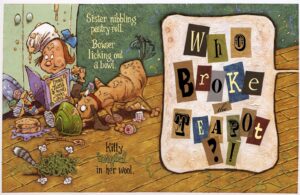 Now kids love a good mystery, and I’m not talking just the 9 and 10-year-olds. Virtually every single age of childhood has a weakness for books that set up mysterious circumstances and then reveal all with a flourish. Heck, why do you think babies like the game of peekaboo? Think of it as the ultimate example of mystery and payoff. Picture book mysteries are, however, far more difficult to write than, say, an episode of Nate the Great. You have to center the book squarely in the child’s universe, give them all the clues, and then make clear to the reader what actually happened. To do this you can show the perpetrator of the crime committing the foul deed at the start of the book or you can spot clues throughout the story pointing clearly to the miscreant. In the case of Who Broke the Teapot, Slavin teaches (in his own way) that old Sherlock Holmes phrase, “When you have eliminated the impossible, whatever remains, however improbable, must be the truth.”
Now kids love a good mystery, and I’m not talking just the 9 and 10-year-olds. Virtually every single age of childhood has a weakness for books that set up mysterious circumstances and then reveal all with a flourish. Heck, why do you think babies like the game of peekaboo? Think of it as the ultimate example of mystery and payoff. Picture book mysteries are, however, far more difficult to write than, say, an episode of Nate the Great. You have to center the book squarely in the child’s universe, give them all the clues, and then make clear to the reader what actually happened. To do this you can show the perpetrator of the crime committing the foul deed at the start of the book or you can spot clues throughout the story pointing clearly to the miscreant. In the case of Who Broke the Teapot, Slavin teaches (in his own way) that old Sherlock Holmes phrase, “When you have eliminated the impossible, whatever remains, however improbable, must be the truth.”
I love it when a book turns everything around at the end and asks the reader to think long and hard about what they’ve just seen. Remember the end of The Cat in the Hat when everything’s been cleaned up just in time and the mother comes in asking the kids what they got up to while she was gone? The book ends with a canny, “Well, what would YOU do if your mother asked YOU?” Who Broke the Teapot?! does something similar at its end as well. The facts have been laid before the readers. The baby has claimed responsibility and maybe he is to blame after all. But wasn’t the mother just as responsible? It would be very interesting indeed to poll a classroom of Kindergartners to see where they ascribe the bulk of the blame. It may even say something about a kid if they side with the baby more or the mommy more.
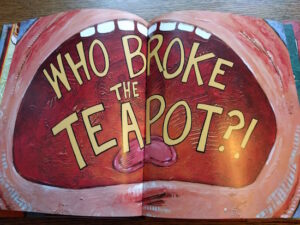 I also love that the flashback does far more than explain who broke the teapot. It explains why exactly most of the members of this family are dwelling in a kind of generally accepted chaotic stew. You take it for granted when you first start reading. A kid’s hanging from a ceiling fan? Sure. Yeah. That happens. But the explanation, when it comes, belies that initial response. The parents don’t question his position so you don’t question it. That is your first mistake. Never take your lead from parents. And speaking of the flashback, let’s just stand aside for a moment and remember just how sophisticated it is to portray this concept in a picture book at all. You’re asking a child audience to accept that there is a “before” to every book they read. Few titles go back in time to explain how we got to where we are now. Slavin’s does so easily, and it will be the rare reader that can’t follow him on this trip back into the past.
I also love that the flashback does far more than explain who broke the teapot. It explains why exactly most of the members of this family are dwelling in a kind of generally accepted chaotic stew. You take it for granted when you first start reading. A kid’s hanging from a ceiling fan? Sure. Yeah. That happens. But the explanation, when it comes, belies that initial response. The parents don’t question his position so you don’t question it. That is your first mistake. Never take your lead from parents. And speaking of the flashback, let’s just stand aside for a moment and remember just how sophisticated it is to portray this concept in a picture book at all. You’re asking a child audience to accept that there is a “before” to every book they read. Few titles go back in time to explain how we got to where we are now. Slavin’s does so easily, and it will be the rare reader that can’t follow him on this trip back into the past.
I think the only real mystery here is why this book isn’t better known. And its only crime is that it’s Canadian, and therefore can’t win any of the big American awards here in the States. It’s also too amusing for awards. Until we get ourselves an official humor award for children’s books, titles like Who Broke the Teapot?! are doomed to fly under the radar. That’s okay. This is going to be the kind of book that children remember for decades. They’re going to be the ones walking into their public libraries asking the children’s librarians on the desks to bring to them an obscure picture book from their youth. “There was a thing that was broken . . . like a china plate or something . . . and there was this cat tied up in string?” You have my sympathies, children’s librarians of the future. In the meantime, better enjoy the book now. Whether it’s read to a large group or one-on-one, this puppy packs a powerful punch.
On shelves now
Source: Publisher sent final copy for review.
Like This? Then Try:


By:
Betsy Bird,
on 8/5/2016
Blog:
A Fuse #8 Production
(
Login to Add to MyJacketFlap)
JacketFlap tags:
Best Books of 2016,
2016 picture books,
2016 reviews,
Reviews 2016,
2016 funny books,
2016 funny picture books,
Reviews,
picture books,
knitting,
funny books,
Roaring Brook,
Best Books,
macmillan,
funny picture books,
Vera Brosgol,
Add a tag
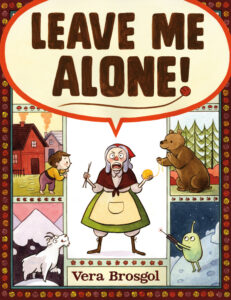 Leave Me Alone!
Leave Me Alone!
By Vera Brosgol
Roaring Brook Press (an imprint of Macmillan)
$17.99
ISBN: 9781626724419
Ages 4-7
On shelves September 13th
Knitting. It shouldn’t be so hard. I say this as the grown daughter of a chronic knitterer (not a word). I grew up neck deep in roving. I know the difference between a gossip wheel and a walking wheel (these are different spinning wheels). I know that if you want a permanent non-toxic dye for wool you use Kool-aid, that wool straight from the sheep is incredibly oily, and that out there are people who have turned the fur of their dogs and cats into sweaters. Yet the simplest act of knitting is lost on a good 50% of the children’s book illustrators out there that year after year can’t even be bothered to figure out which way the knitting needles are supposed to go. Down, people. The ends go down. In 2016 alone we’ve seen books like Maggie McGillicuddy’s Eye for Trouble get it wrong. Fortunately 2016 has also seen correctly positioned needles in Cat Knit, Ned the Knitting Pirate, and the greatest knitting related picture book I’ve seen to date Leave Me Alone! A superb readaloud of unparalleled visual humor, this is a knitting picture book par excellence and a pretty darn good original folktale too, come to think of it. Allowing for the occasional alien, of course.
“Once there was an old woman. She lived in a small village in a small house . . . with a very big family.” And by big family we mean big extended family. One gets the feeling that all her grown kids just sort of dump their own children on her, because there are thirty small grandchildren running amok in her home. Winter is coming soon and the old woman is keen on getting some knitting done for her extended brood. Trouble is, knitting and small children do NOT mix. So she picks up her stuff and goes into the deep, dark forest. That’s where the bear family finds her. So she goes to the mountains. Where the goats find her. Next it’s the moon. Where curious aliens find her. That leaves a wormhole where the void turns out to be her saving. Only problem is, it’s lonely in the void. Once her work is done, she heads back and when she sees her grandkids again, she doesn’t have to say a single word.
Here is the crazy thing about this book: It’s Vera Brosgol’s first picture book. I say that this is crazy because this does not read like a debut. This reads like Brosgol has been churning out picture books for decades, honing her skill, until finally at long last she’s produced a true diamond. But no. Some people get all the talent apparently. This is not, I should not, Ms. Brosgol’s first book in general. Her graphic novel Anya’s Ghost got a fair amount of attention a couple of years ago, and it was good. But nothing about that title prepared me for Leave Me Alone! Here we have a pitch perfect combination of text and image. If you were to read this book to someone without mentioning the creator, I don’t think there’s a soul alive who wouldn’t assume that the author and illustrator are one and the same. This is due largely to the timing. Just open the book to the first page. Examine the old woman on that page. Turn the page. Now look how that same woman has been transposed to a new setting and her expression has changed accordingly. Basically this sold the book to me right from the start.
 Funny picture books. For an author, creating a picture book that is funny means doing two things at once. You must appeal to both children and parents with your humor at the same time. Do you know how hard that is? Making something that a five-year-old thinks is funny that is also humorous to their parental unit is such a crazy balancing act that most picture book creators just fall on one side of the equation or the other. Make it funny only to adults and then you may as well just forget about the kids altogether (see: A Child’s First Book of Trump). Opt instead to only make it funny to kids and you doom the grown-ups to reading something they’d rather eat hot nails than read again (see: Walter the Farting Dog). But I honestly believe Brosgol has found the golden mean. Both adults and kids will find moments like the older sister stuffing a yarn ball in her brother’s mouth or the presence of the samovar (even in a wormhole) or the bear tentatively touching its nose after the old woman’s vigorous poke very funny indeed.
Funny picture books. For an author, creating a picture book that is funny means doing two things at once. You must appeal to both children and parents with your humor at the same time. Do you know how hard that is? Making something that a five-year-old thinks is funny that is also humorous to their parental unit is such a crazy balancing act that most picture book creators just fall on one side of the equation or the other. Make it funny only to adults and then you may as well just forget about the kids altogether (see: A Child’s First Book of Trump). Opt instead to only make it funny to kids and you doom the grown-ups to reading something they’d rather eat hot nails than read again (see: Walter the Farting Dog). But I honestly believe Brosgol has found the golden mean. Both adults and kids will find moments like the older sister stuffing a yarn ball in her brother’s mouth or the presence of the samovar (even in a wormhole) or the bear tentatively touching its nose after the old woman’s vigorous poke very funny indeed.
And let’s not downplay the writing here. There is serious readaloud potential with this book. I’ll level with you. In a given year you’ll see hundreds and hundreds of picture books published. Of these, a handful make for ideal readalouds. I’m not talking about books a parent can read to a child. I’m talking about books you can read to large groups, whether you’re a teacher, a librarian, or some poor parental schmuck who got roped into reading aloud to a group of fidgeting small fry. Few books are so good that anyone and everyone can enrapture an audience with them when read out loud. But Leave Me Alone! may be one of those rare few. Those beautiful butterflies. Those little jewels. The language mimics that of classic folktales, bandying about phrases like, “deep, dark forest”. And there are so many interactive possibilities. You could teach the kids how to yell out the phrase “Leave me alone!” all together at the same time, for example.
 As for the art, it’s perfect. There’s a kind of Kate Beaton feel to it (particularly when babies or goats have full balls of yarn stuffed into their mouths). As I mentioned before, Brosgol knows which way knitting needles are supposed to lie, and better still she knows how to illustrate thirty different, and very realistically rendered sweaters, at the story’s end. There are also some clever moments that you’ll notice on a third or fourth read. For example, the very first time the woman yells, “Leave me alone!” she’s exiting the gates to her home and her children’s homes. The only people who hear her are her grown children, which means we don’t have to worry about small ears hearing such a caustic phrase from their grandma. Smart. And did you see that the twins get identical sweaters at the end of the book? Finally, there are the visual gags. The goats that surreptitiously followed the old woman to the moon, nibbling on a moon man’s scanner, for example.
As for the art, it’s perfect. There’s a kind of Kate Beaton feel to it (particularly when babies or goats have full balls of yarn stuffed into their mouths). As I mentioned before, Brosgol knows which way knitting needles are supposed to lie, and better still she knows how to illustrate thirty different, and very realistically rendered sweaters, at the story’s end. There are also some clever moments that you’ll notice on a third or fourth read. For example, the very first time the woman yells, “Leave me alone!” she’s exiting the gates to her home and her children’s homes. The only people who hear her are her grown children, which means we don’t have to worry about small ears hearing such a caustic phrase from their grandma. Smart. And did you see that the twins get identical sweaters at the end of the book? Finally, there are the visual gags. The goats that surreptitiously followed the old woman to the moon, nibbling on a moon man’s scanner, for example.
I’ve seen a fair amount of hand wringing over the years over whether or not a children’s book can contain a protagonist that is not, in fact, a child, an animal, or an inanimate object rendered animate. Which is to say, are children capable of identifying with adults? More precisely, an adult who just wants to be alone for two seconds? The answer is swift and sure. Certainly they can. Particularly if the kid reading this book is an older sibling. The concept of being alone, of craving some time for one’s own self, is both familiar and foreign to a lot of kids. I’m reminded of the Frog & Toad story “Alone” from Days With Frog and Toad where Toad has a dark morning of the soul when he learns that Frog would like to have some alone time. Because of all of this, we see a lot of picture books where a character wants to be alone, has difficulty getting that “me time”, and eventually decides that companionship is the way to go (Octopus Alone, A Visitor for Bear, etc.). A few celebrate the idea (All Alone] by Kevin Henkes) but generally speaking parents use these books to convince their perhaps less than socially adept children that there are benefits to the concept of friendship. And there is a place in the world for such books. Fortunately there is also a place in the world for this book.
Folks sometimes talk to me about current trends in picture books. Sometimes they’re trying to figure out what the “next big thing” might be. But of course, the best picture books are the ones that at their core don’t really resemble anything but themselves. Leave Me Alone! isn’t typical. It reads aloud to big crowds of kids with great ease, lends itself to wonderful expressions, pops off the page, and will make anyone of any age laugh at some point. It’s a great book, and if I have to write another 500 words to convince you of it, I can do so. But why delay you from seeing it any longer? Go. Seek. Find. Read. Savor.
On shelves September 13th.
Like This? Then Try:
Source: Galley sent by publisher for review.
Misc: Cute promotion or THE CUTEST PROMOTION? As you can see from this Bustle interview, Ms. Brosgol knit twenty-five teeny tiny sweaters to promote this book. I steal the image for my own nefarious purposes and show it to you here:


Thusly is the deal. Since taking a job in Evanston, I’m not the big time reader I used to be. I just don’t devour the books as quickly as I once did, nor do I have access to a committee that would discuss a wide range of children’s literature. As such, I’ve decided that the only area where I can reasonably concentrate my efforts is on picture books. So every day at lunchtime I dutifully grab 5-7 picture books and read through them. Even at this rate, this is my To Be Read shelf:
Yet I’ve been lucky enough to see books that are so good that I just want to share them with you today. After all, not sharing their titles feels like hoarding to me. Here then are ALL the 2016 picture books that I think are truly extraordinary. Don’t see something you love? Just assume it’s in that To Be Read pile somewhere.
This list does not include reprints, board books, folktales, nonfiction, or easy books at this time.
Oh. And remember when I said I don’t envy this year’s Caldecott committee because we have WAY too many strong books? Here’s a taste of what I mean (though obviously these aren’t all eligible):
Some of the Best Picture Books of 2016 (Thus Far)
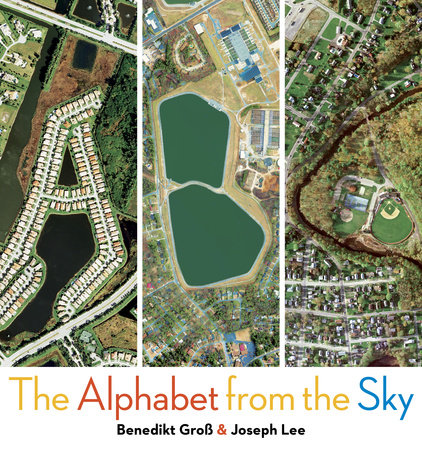
ABC: The Alphabet From the Sky by Benedikt Grob & Joey Lee
Yep. It’s an alphabet book based entirely on aerial photography. Crazy thing is, it works. And it’s exceedingly clever. Best of all, if you nitpick any of the chosen letters, they have alternatives in the back of the book. Oddly mesmerizing too.

The Airport Book by Lisa Brown
I already reviewed this one so no surprises here. Just nice to see the rest of the country catching up with my wuv.

Animals by Ingela P. Arrhenius
It’s French, can’t you tell? It’s also gigantic. Coming in at a whopping 13.4 x 18.1 inches it’ll be a nightmare for libraries and a boon to preschools and daycares everywhere. It’s also privy to exceedingly clever typography. When you get it, check out how the animals and their descriptive words match one another.

Armstrong by Torben Kuhlmann
For those of us enamored of Lindbergh, Kuhlmann’s follow-up couldn’t come fast enough. If you run any Calde-not contests this year, better include this one.
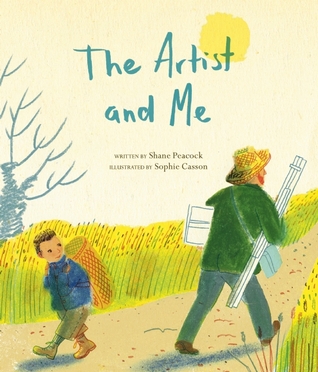
The Artist and Me by Shane Peacock, ill. Sophie Casson
It’s a Van Gogh book! It’s a bullying book! Well now you can have both. I don’t usually go for this kind of thing, but Peacock handles the subject of casual childhood cruelty with aplomb.

An Artist’s Alphabet by Norman Messenger
Again with the alphabet books. Still, you’ll almost never find one like this. Not only does it have animals, fruits, insects, and other natural phenomena in the shapes of the capital letters, but the lower-case as well. Plus it’s purdy.

The Bear and the Piano by David Litchfield
This one has a slow burn. You read it once and it’s good. Then you think about it for a long time and come back to it again and again and again. It’s about leaving home, seeing the world, and taking what you’ve learned back to the people who supported you in the beginning.

Before Morning by Joyce Sidman, ill. Beth Krommes
There’s a whiff of Caldecott around this one. It’s a very simple story of a girl who wishes her pilot mom could just stay home this once. Better not look at the cover. It’s a spoiler alert of what happens next.
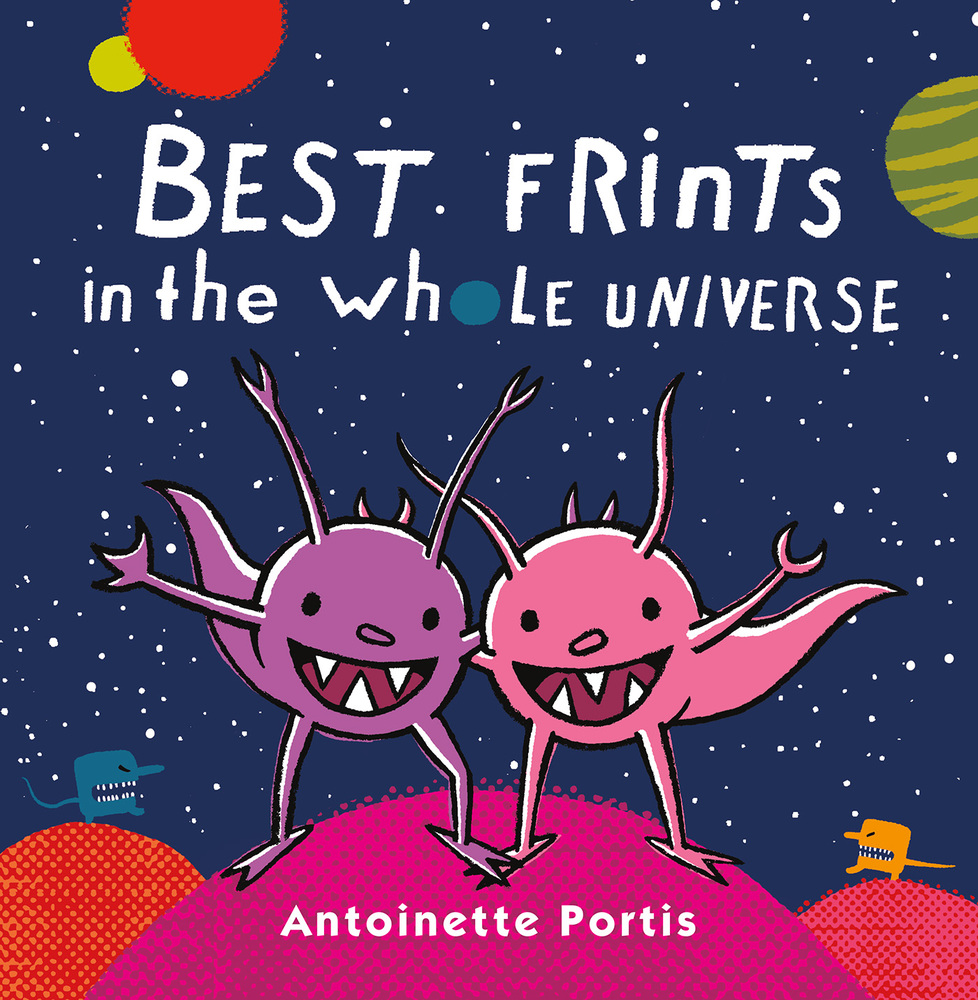
Best Frints in the Whole Universe by Antoinette Portis
Because everybody could use more frints. That and the fact that it’s Portis and she really lets go and has fun with this one.
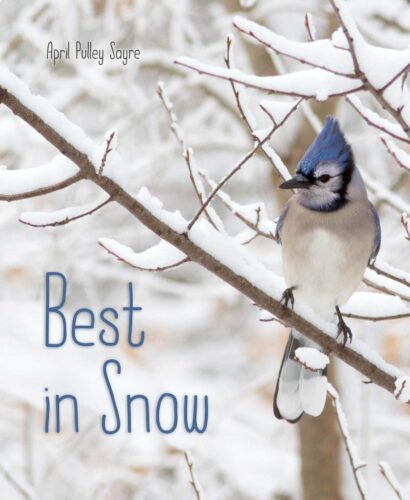
Best in Snow by April Pulley Sayre
Nope. We still don’t know what to do with Sayre’s photo picture books. Nonfiction or fiction? Poetry or picture books? The choices are infinite. The books are exquisite.
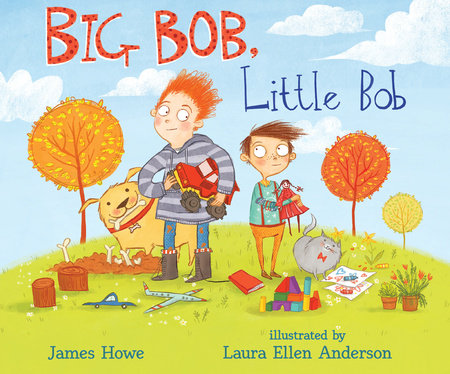
Big Bob, Little Bob by James Howe, ill. Laura Ellen Anderson
Further proof that you can write a book about rejecting gender stereotypes in a smart, new way. This is William’s Doll for a new generation. Little wonder it came from James Howe. Plus I love that it’s the girl in the book that does the reinforcing of stereotypes. In my experience that is often the case.

A Bike Like Sergio’s by Maribeth Boelts, ill. Noah Z. Jones
It used to be that picture books would confront the notion of economic disparity regularly. Not so these days though there are always exceptions to the rule. Boelts already won my love with her Happy Like Soccer. This continues the thread.
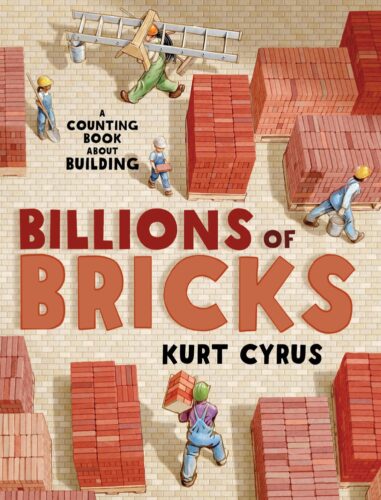
Billions of Bricks: A Counting Book About Building by Kurt Cyrus
Every. Single. Brick. Cyrus can account for every single one. It rhymes. It builds. It’s alluring to the construction obsessed and the not-so-construction obsessed. Two thumbs way way up over here.

Can I Eat That? by Joshua David Stein, ill. Julia Rothman
I probably shouldn’t confess this but I always look at Phaidon books with a bit of skepticism. When I get one I have to ask myself, “Is is artsy for grown-ups or fun for kids?” The answer to this book was, “Yes.” Everyone can find something to love here. It upsets expectations wildly. However, a friend rightly pointed out that it is DEFINITELY a book for a certain economic strata. FYI.

Can One Balloon Make an Elephant Fly? by Dan Richards, ill. Jeff Newman
I gave this book to my child’s preschool teacher and the woman went crazy for it. She just thinks it’s the cleverest thing this side of the sun. She isn’t wrong. Plus you get the extra added bonus of seeing more Jeff Newman art. I love that guy.
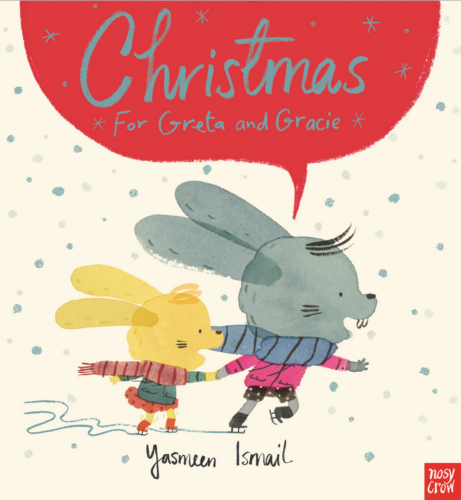
Christmas for Greta and Gracie by Yasmeen Ismail
If you know me then you know I’m not going to put a holiday book on this list unless it is truly extraordinary. Ismail, who has consistently done amazing work, really goes above and beyond with this one. Younger siblings everywhere will adore it.

City Shapes by Diana Murray, ill. Bryan Collier
I come to Collier with an open mind most of the time. I like his art but I don’t like it every time. Fortunately he’s in top notch form here. Nothing like a good old-fashioned concept book.

Come Home, Angus by Patrick Downes, ill. Boris Kulikov
Another one where I read it the first time and merely liked it. Came back to it later and was struck by the intelligence of the writing and, of course, Kulikov’s fabulous art.
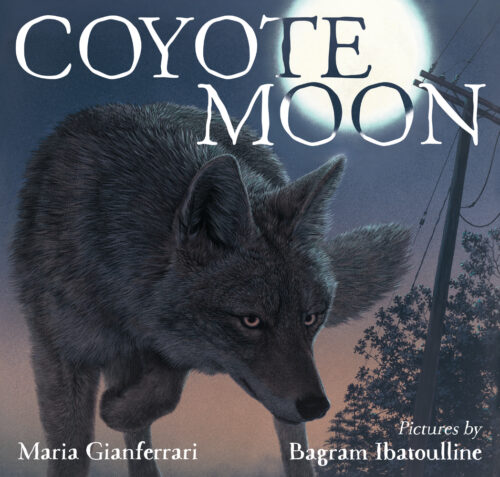
Coyote Moon by Maria Gianferrari, ill. Bagram Ibatoulline
Yep. Reviewed it already. So glad that I did. Talk about a timely subject. Them coyotes is everywhere!
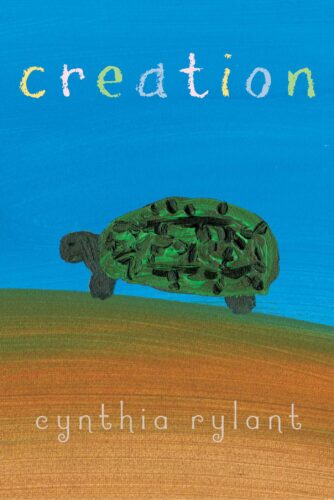
Creation by Cynthia Rylant
Not usually my kind of thing. I might normally eschew this kind of book as too artsy for my tastes. Yet reading it just now I was struck by the beauty of the thick thick paints. Pair it with Miracle Man for kicks.
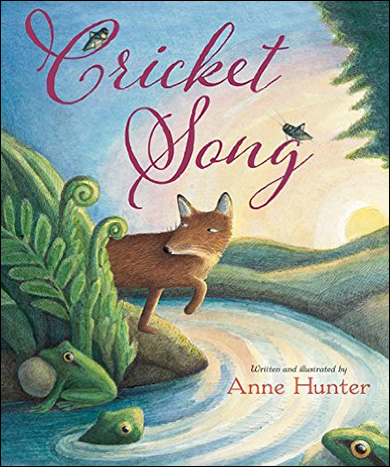
Cricket Song by Anne Hunter
Despite the fact that it has a cute fox on the cover this is more of a look at time passing and distance than anything else. A truly lovely bedtime book.

Cry, Heart, But Never Break by Glenn Ringtved, ill. By Charlotte Pardi
Alternate Title: Every single country in the world talks about death in picture books better than America. Well, it’s true. And this may be the most sensitive of them this year. An import worth importing.
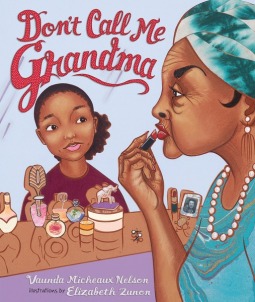
Don’t Call Me Grandma by Vaunda Micheaux Nelson, ill. Elizabeth Zunon
Shoot. I still adore this. I reviewed it here and I’d re-review it all over again if it meant getting you to notice it. Raise a questionable glass to spiky relatives everywhere!
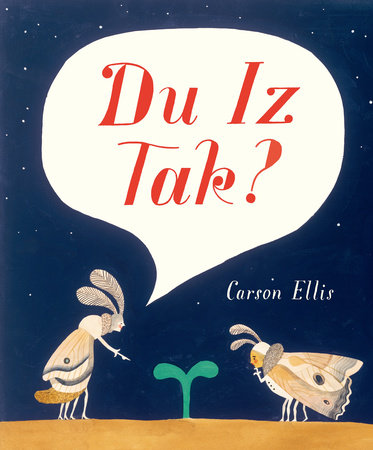
Du Iz Tak? by Carson Ellis
Sometimes I wonder if I just like some books because I didn’t like others. I feel really quite guilty that I haven’t reviewed this one yet. Its made up language is so simple and so fun to read. The plot, such as it is, is easy to follow. I just adore it (though I do wonder if that stickbug died midway through the tale).

Dylan the Villain by K.G. Campbell
A great book, sure enough, but I’m giving it extra points for suggesting that super-villainy is genetic. Plus the antagonist is a girl with a purple eye-patch. Extra points for that one.

Elliot by Julie Pearson, ill. Manon Gauthier
Not everyone is going to agree with me on this one, and I accept that. Still, I feel that used in the right context, this book does something that no other book does. Confused? Read my review and all will be clear. Just don’t pick it up expected a cute fuzzy bunny story.
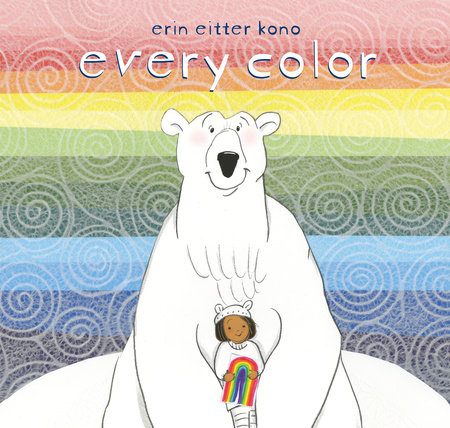
Every Color by Erin Eitter Kono
A polar bear searching for color? Haven’t we seen that plot before? Sorta. The difference is simply that this book does it better.
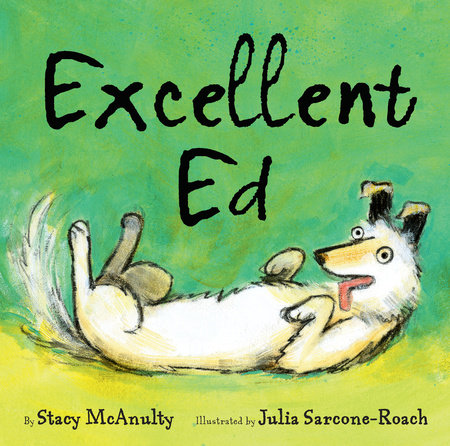
Excellent Ed by Stacy McAnulty, ill. Julia Sarcone‐Roach
They’ll sell this book to you based entirely on its casual diversity. That is a factor, but the storyline and writing and art are the additional standouts that give it a leg up.
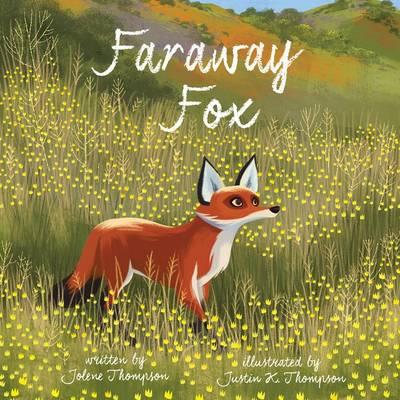
Faraway Fox by Jolene Thompson, ill. Justin K. Thompson
As Travis pointed out earlier, 2016 is the year of the fox. Much of what I like about this title, aside from the art which is stellar, is the fact that it’s a book with a purpose above and beyond telling a good story. Fox family reunification makes for a good story too, though.
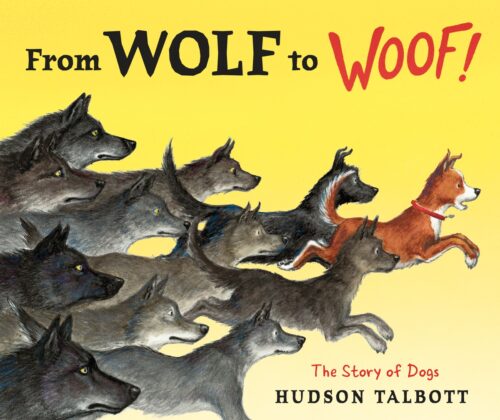
From Wolf to Woof!: The Story of Dogs by Hudson Talbott
Sometimes these books straddle the picture book and nonfiction line. But with its story of a boy bonding with a wolf (that shot of his hand on its head is worth the price of admission alone) I’d say it counts. Man does a good dog, too.
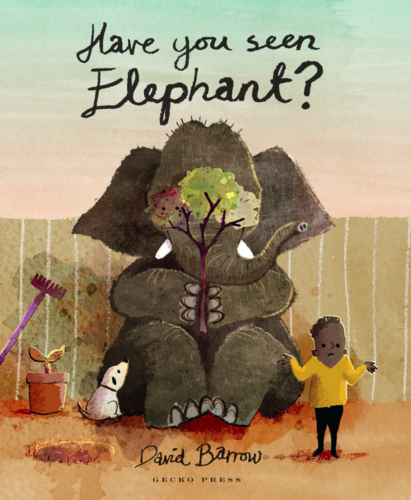
Have You Seen Elephant? by David Barrow
I love that kid’s expression. Like he really and truly has no clue where the pachyderm is looming.
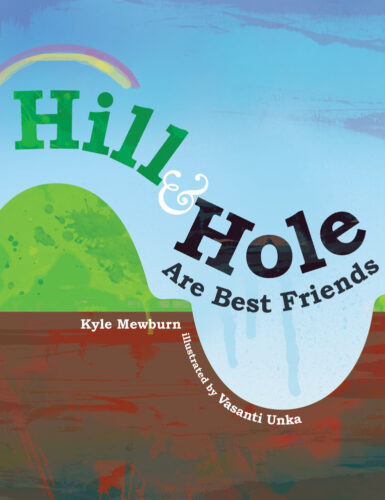
Hill & Hole Are Best Friends by Kyle Mewburn, ill. Vasanti Unka
There’s an odd little melancholy to this book about being satisfied with your lot. The ending hints at what the future may hold without insisting upon it. It’s a book and a metaphor all at once.

How to Track a Truck by Jason Carter Eaton, ill. John Rocco
The book I didn’t even know I was waiting for until it arrived. Lots to love here. If you enjoyed How to Train a Train, then you won’t be disappointed. Rocco is in his element.
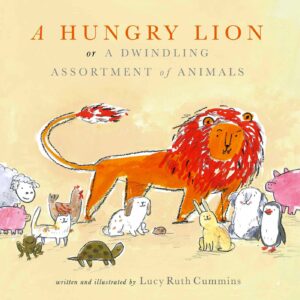
A Hungry Lion by Lucy Ruth Cummins
A show of hands. How many of you just assumed that this was a British import? Yep. Well, it isn’t. It does, however, have a lovely twist ending.

Ideas Are All Around by Philip Stead
Another one of those books that may or may not be for kids. In the end, the title of this book is about “Picture Books” and there is always the odd child that will become enamored of the title. It is pretty gorgeous.

It’s Not Easy Being Number Three by Drew Dernavich
Someone earlier this year asked me to list all the extraordinary math or number picture books out in 2016. The count was pitifully small. Fortunately, Dernavich is here to save the day. Trucker hat and all (seriously, that 3 is wearing a GREAT hat.
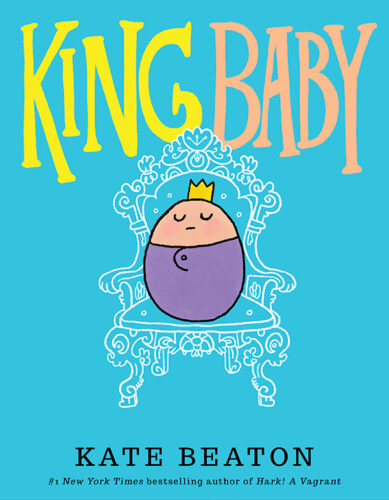
King Baby by Kate Beaton
Just for fun, do a Google image search of this title and author. Now read all the comics she’s put up there. More than just a larf for new parents.
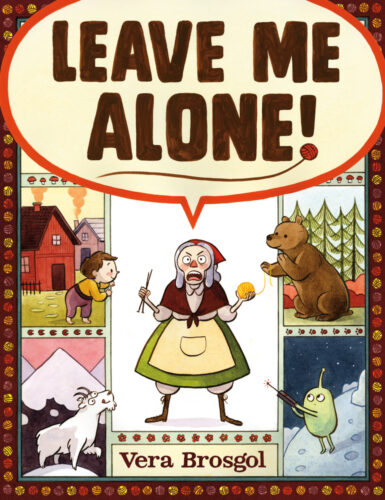
Leave Me Alone! by Vera Brosgol
This may be my favorite picture book of the year. Dunno. I need to think about it for a while. A review of it should be posted on this site this week, at the very least.

Let Me Finish by Minh Le, ill. Isabel Roxas
Isn’t it nice when a friend of yours writes a book and it’s not only good, it’s one of the best of the year. Not too shabby there, Minh.
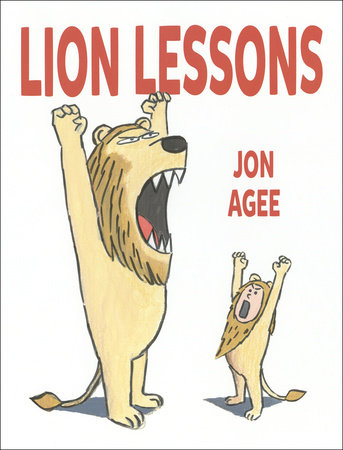
Lion Lessons by Jon Agee
One of these days Agee’s gonna lose his ability to write such good books. Any minute now . . . any minute . . .
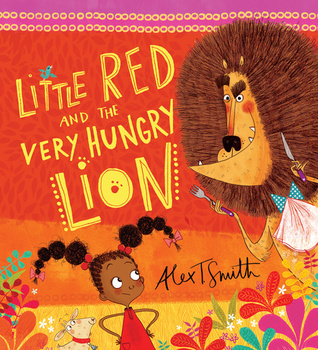
Little Red and the Very Hungry Lion by Alex T. Smith
Excellent storytelling, great art, and if you’ve ever wondered to yourself what a lion’s mane would look like in cornrows, I think I know where you can go to find an answer. I hesitate to use the word “spunky” on this girl, so I’ll just call her “intrepid” and “intelligent” instead.
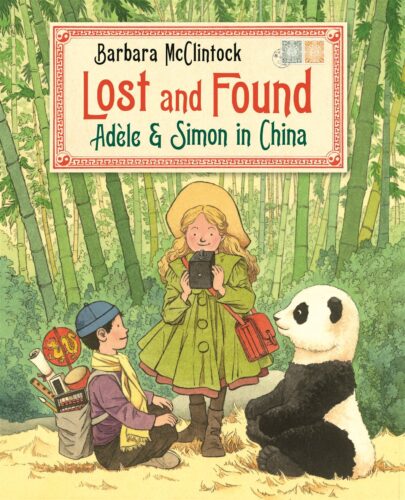
Lost and Found: Adele & Simon in China by Barbara McClintock
A book for VERY young eyes. I’m beginning to wonder if Ms. McClintock paints with the aid of electronic microscopes. Someday she’s going to paint a book on the head of a single grain of rice. I would read that rice.
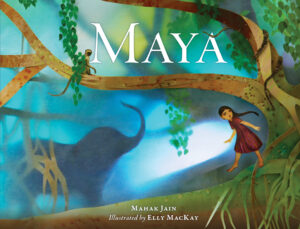
Maya by Mahak Jain, ill. Elly MacKay
Empowering. Beautiful. Dreamlike. And I got to have a long conversation with my daughter about banyan trees, thanks to the storyline.

Maybe Something Beautiful: How Art Transformed a Neighborhood by F. Isabel Campoy & Theresa Howell, ill. Rafael Lopez
His art just makes me happy every time I see it. I’ll never get a tattoo, but if I absolutely had to have one, it might have to be of one of his images. A premiere of the book trailer here, if you’re interested.

Monday Is Wash Day by MaryAnn Sundby, ill. Tessa Blackham
Artistry, when done well and for the right reasons, yields classics. And look at th0se cut paper clothes. A steady hand needed there.
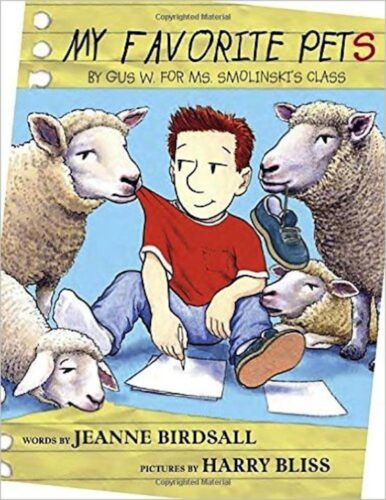
My Favorite Pets by Gus W. for Ms. Smolinski’s Class by Jeanne Birdsall, ill. Harry Bliss
Birdsall! Bliss! Hungry sheep! The story doesn’t exactly write itself, but when the final form is made clear it makes perfect sense.
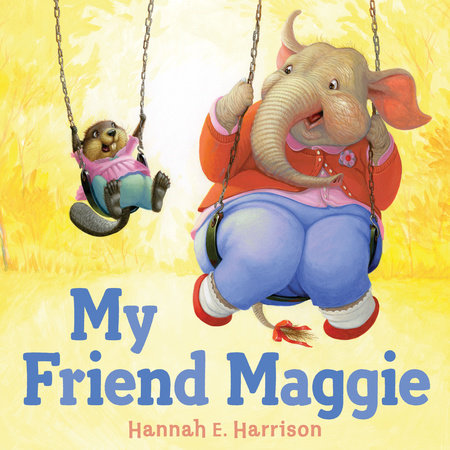
My Friend Maggie by Hannah E. Harrison
I was tepid on Harrison’s first picture book, enticed by her second, and enthralled by this, her third. The cruel cuts of elementary school are keenly felt here. And the expressions on the animals’ faces? Classic.
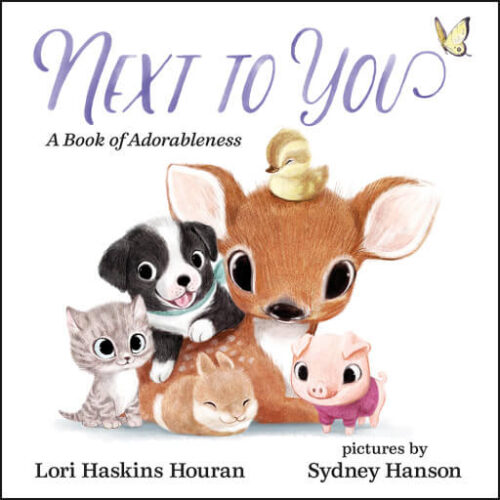
Next to You: A Book of Adorableness by Lori Haskins Houran, ill. Sydney Hanson
Aw, yeah. I am so keeping this one the list. Read the review here to know why.
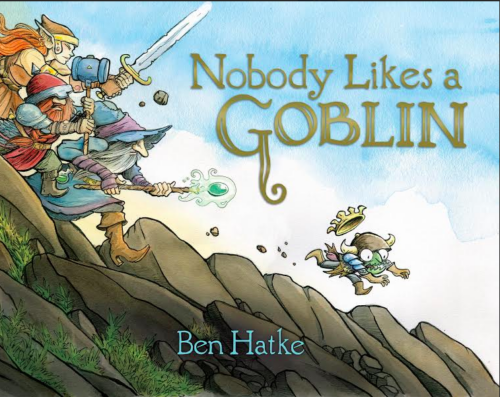
Nobody Like a Goblin by Ben Hatke
And with this book I interviewed Ben and he showed off the alternate cover. I think, after looking at it, you’ll understand why they went with this one.
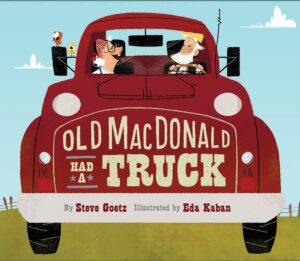
Old MacDonald Had a Truck by Steve Goetz, ill. Eda Kaban
I have read this book roughly 500 million times to my 2-year-old son. I still like this book even after all of that. That tells me it must be pretty good. There’s always something new to see.

One Day in the Eucalyptus Eucalyptus Tree by Daniel Bernstrom, ill. by Brendan Wenzel
Such a brilliant readaloud! I know there’s another Wenzel book out there that I’m supposed to like more, but you never forget your first. And for me, this was the first Wenzel story I ever really loved. There will be others.

Pond by Jim LaMarche
There are at least two picture books out this year about damming up streams to make ponds. I like this one a lot. Kids really do like to hear about process sometimes. It would actually pair well with Ellen Obed’s Twelve Kinds of Ice.
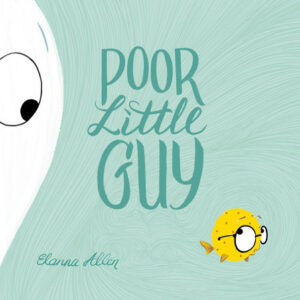
Poor Little Guy by Elanna Allen
I’m an adult and the surprise ending on this book caught me unawares. Plus I love a good animator-turned-illustrator. This hits all the right picture book beats. Warning: May make you hungry for sushi.
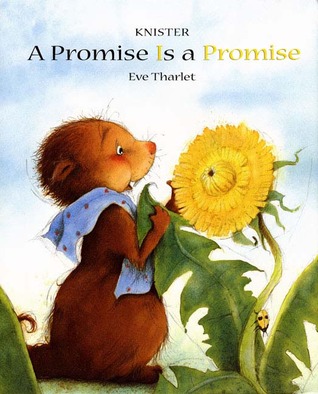
A Promise Is a Promise by Knister, ill. Eve Tharlet
Another import about death. This one has a rather hopeful bent to it, though. It’s not the kind of art I usually like, but the storytelling overcame that personal prejudice.

Rabbit Magic by Meg McLaren
How long McLaren took to get those background bunnies right, I do not know. Once I get the hardcover I’ll be able to sit down and determine if every single bunny in this book has a different personality. I have a theory that this is the case . . .
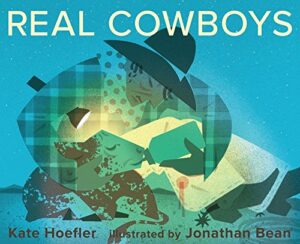
Real Cowboys by Kate Hoefler, ill. Jonathan Bean
I just got this in yesterday. Shoot. I think it’s also a Caldecott contender. Bean’s usually a sure shot in that area, but it’s Hoefler’s text that raises the book out of the morass of other picture books. I never thought I could like a contemporary cowboy book so much.
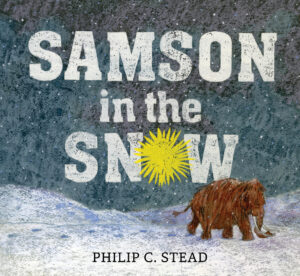
Samson in the Snow by Philip C. Stead
I know, I know. If I include both of the Philip C. Stead books out this year, one of the two should have to go. But not this one! It’s so cute and friendly, with that hint of melancholy Mr. Stead always takes care to include, no matter how happy the tale.

School’s First Day of School by Adam Rex, ill. Christian Robinson
How many starred reviews has it gotten? Six? Seven? Then I think we can all agree that it’s probably the best going-to-school book on the market today. Pair it with Mom, It’s My First Day of Kindergarten for a truly inspired pairing.

The Shady Tree by Demi
Aw. This is Demi at her best. An original folktale with a cute and clever bent. Great tone as well.
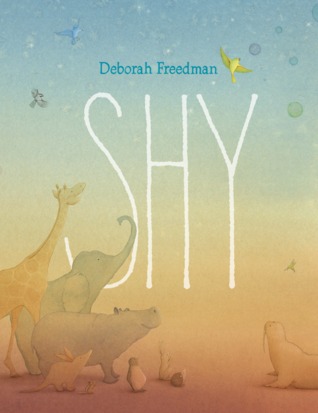
Shy by Deborah Freedman
In my experience even the not-so-shy kids get a kick out of this one. Plus they’ll love going back through the book to spot Shy on the previous pages.

Skypig by Jan L. Coates, ill. Suzanne Del Rizzo
Crazycool art going on here. I think it’s all clay, but it’s hard to tell. Whatever the medium is, it fits the storyline perfectly. I always have so much fun reading the book that I forget to look up how it’s made.
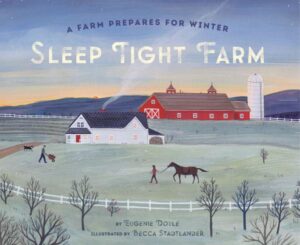
Sleep Tight Farm: A Farm Prepares for Winter by Eugenie Doyle, ill. Becca Stadtlander
An Ox-Cart Man for the 21st century!

The Storm by Akiko Miyakoshi
You can practically taste the disappointment when that storm rolls in. It didn’t quite reach the heights of its predecessor The Tea Party in the Woods, but it’s still a studied, smart take on a common childhood experience.
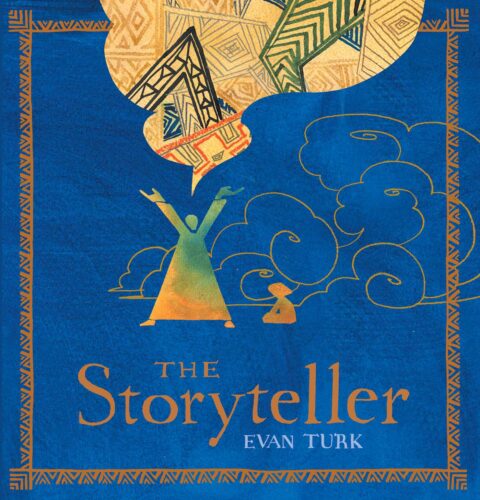
The Storyteller by Evan Turk
What else could I even possibly tell you about this? Maybe it’ll finally be Turk’s year. He’s talented enough. My review of the book can be found here.
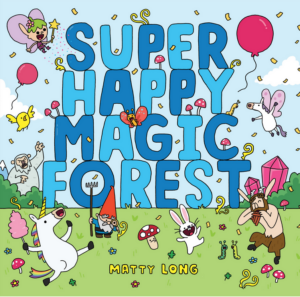
Super Happy Magic Forest by Matty Long
You may notice that this isn’t too dissimilar to Nobody Likes a Goblin. So I clearly have a penchant for picture books that upset fantasy expectations. Both books also look at the nature of quests.
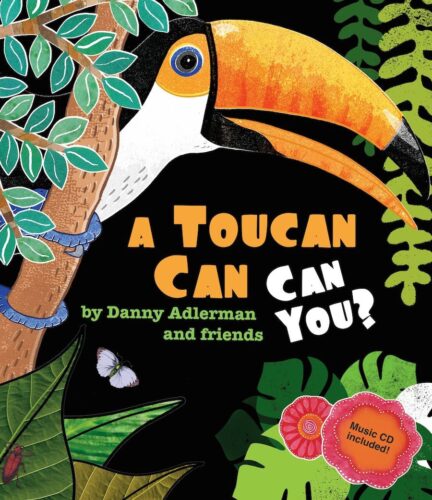
A Toucan Can, Can You? by Danny Adlerman, ill. Various
Love it! Reviewed it recently here. The sheer array of artists makes this one a keeper. Plus it’s catchy. There is much to be said for catchy.
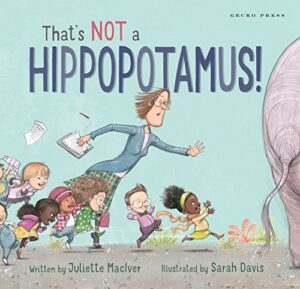
That’s Not a Hippopotamus! by Juliette Maclver, ill. Sarah Davis
Also a big hit in my child’s daycare. It has all the frantic energy of something like Catch That Cookie, but it also speaks to those quiet kids in a class. Good-natured, funny, and a fabulous readaloud to groups of kids.

They All Saw a Cat by Brendan Wenzel
Yeah. I stand by everything I’ve said about this book already. One of the best of the year. Bar none.

This Is My Dollhouse by Giselle Potter
At some point here I’ll show you my daughter’s dollhouse. One that was inspired by this book. She’s been working on it every night after daycare. Giselle Potter, you are a genius and I thank you.

The Three Lucys by Hayan Charara, ill. Sara Kahn
Tougher subject matter than your average picture book (and it could comfortably slot in the war and bereavement categories) there’s depth and carefully weighted words at work here.
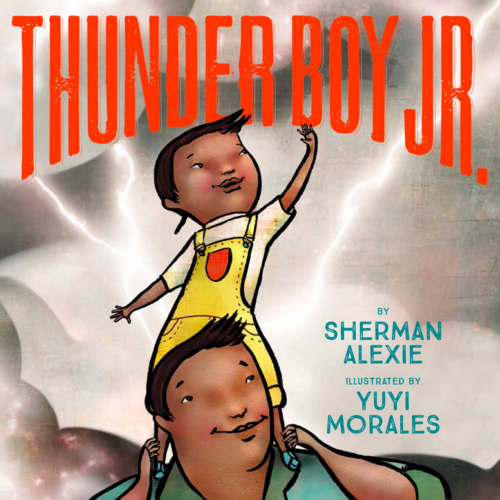
Thunder Boy Jr. by Sherman Alexie, ill. Yuyi Morales
I had to have folks explain to me the brilliance of the art. Once I saw it, I could never unsee it. I have heard and understand the concerns, and even agree with them. Nevertheless, this is one of the strongest books of the year. No question.

The Uncorker of Ocean Bottles by Michelle Cuevas, ill. Erin E. Stead
Not that Philip E. Stead ever cornered the market on sweet melancholy. His wife has her own brand at hand.

The Water Princess by Susan Verde, ill. Peter H. Reynolds
Exceedingly beautiful and useful. Give it to any girl looking for princess fare. It’s not what they think they want, but few will turn it away. Plus it was hugely useful in telling my kid about how lucky we are to have water.
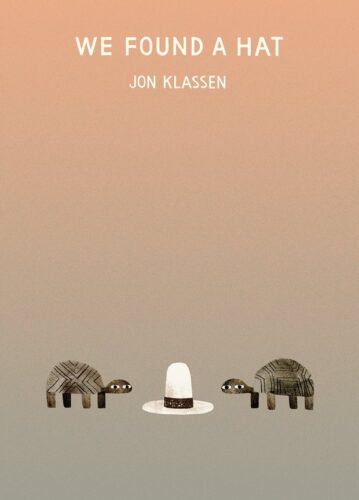
We Found a Hat by Jon Klassen
The sweetness of this book caught me off-guard. I’m adding the image of a turtle wearing an oversized hat to my list of Possible Tattoos I’ll Never Get, But Would At Least Consider.
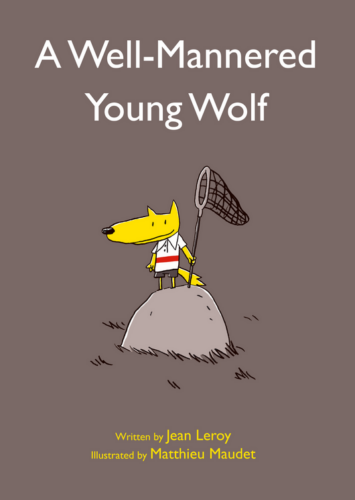
A Well‐Mannered Young Wolf by Jean Leroy, ill. Matthieu Maudet
The ending caught me by surprise. In the best way possible. Definitely NOT American (thank goodness).
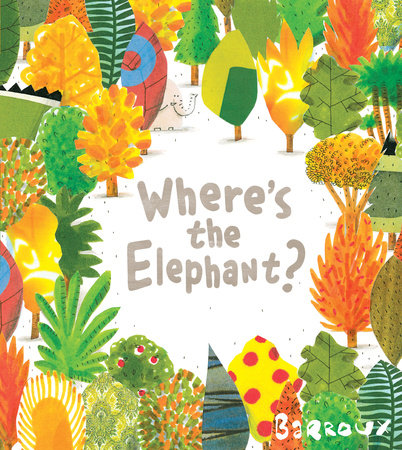
Where’s the Elephant? by Barroux
I love how this book sets up the expectation that it’s just another seek and find story and then slowly reveals that it has a bigger point to convey.

Who Broke the Teapot? by Bill Slavin
I was recently in Stratford, Ontario and this book was in a bookstore window. Little wonder. The art is clever and the solution to the mystery (because this really is a mystery in a picture book) is great. And funny, come to think of it.
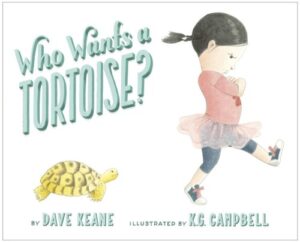
Who Wants a Tortoise? by Dave Keane, ill. K.G. Campbell
Hmm. Two Campbell books as well. The man is a master of illustrated a distressed tortoise. Plus it’s kept me from calling turtles tortoises in the recent past.

Wild Eggs: A Tale of Arctic Egg Collecting by Suzie Napayok‐Short, ill. Jonathan Wright
It’s not a good list unless I can get a book from Inhabit Media on here somewhere. And Napayok-Short’s text is just lovely. Some kids may get disappointed that they can’t collect arctic eggs of their own, of course.
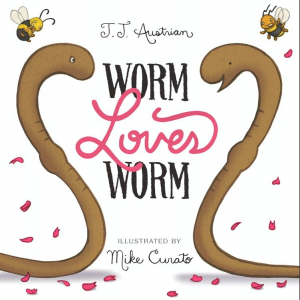
Worm Loves Worm by J.J. Austrian, ill. Mike Curato
Yet another case of a picture book subtly reinforcing a belief or understanding. Would actually pair with the aforementioned James Howe book exceedingly well.
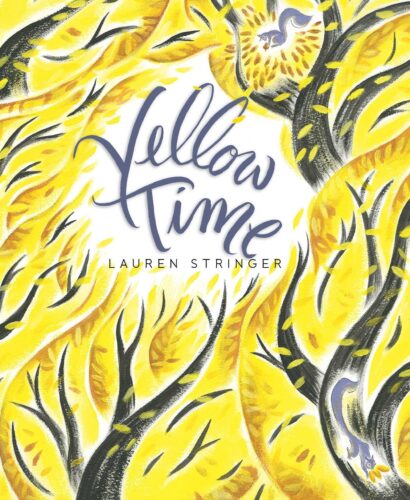
Yellow Time by Lauren Stringer
Baby, there is always time for yellow time. Always.


By:
Betsy Bird,
on 7/14/2016
Blog:
A Fuse #8 Production
(
Login to Add to MyJacketFlap)
JacketFlap tags:
Megan Halsey,
Wendy Anderson Halperin,
picture book readalouds,
2016 picture books,
2016 reviews,
Reviews 2016,
2016 picture book readalouds,
Christee Curran-Bauer,
Danny Adlerman,
Dar (Hosta),
Jim Babjak,
Kevin Kammeraad,
Kim Adlerman,
picture book song books,
Ralph Masiello,
Symone Banks,
The Kids at Our Home,
Reviews,
Lindsay Barrett George,
Demi,
Ashley Wolff,
Leeza Hernandez,
Pat Cummings,
Add a tag
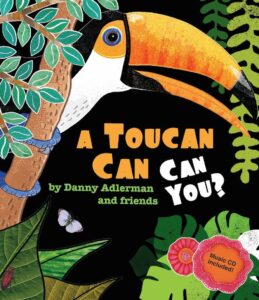 A Toucan Can, Can You?
A Toucan Can, Can You?
By Danny Adlerman
Illustrated by Lindsay Barrett George, Megan Halsey, Ashley Wolff, Demi, Ralph Masiello, Wendy Anderson Halperin, Kevin Kammeraad, Pat Cummings, Dar (Hosta), Leeza Hernandez, Christee Curran-Bauer, Kim Adlerman, and Symone Banks
Music by Jim Babjak
The Kids at Our House Children’s Books
$19.95
ISBN: 9781942390008
Ages 3-6
On shelves now
Under normal circumstances I don’t review sequels. I just don’t, really. Sequels, generally speaking, require at least a rudimentary knowledge of the preceding book. If I have to spend half a review catching a reader up on the book that came before the book that I’m actually reviewing, that’s just a waste of everyone’s time. Better to skip sequels entirely, and I include chapter book sequels, YA sequels, middle grade sequels, nonfiction sequels, graphic novel sequels, and easy book sequels in that generalization. I would even include picture book sequels, but here I pause for a moment. Because once in a while a picture book sequel will outshine the original. Such is the case with Danny Adlerman’s audibly catchy and visually eclectic A Toucan Can, Can You? A storyteller’s (and song-and-dance parent’s) dream, the book is is a sequel to the book How Much Wood Could a Woodchuck Chuck but comes into its own as a writing assignment for some, a storytime to others, and a darn good book for everybody else.
Many of us are at least passingly familiar with that old poem, “How much wood could a woodchuck chuck if a woodchuck could chuck wood?” But why stop with the woodchuck? What other compound words can you break up in amusing ways? And so we are sucked into a delightful world of teaspoons spooning tea, spaceships shipping space, and ice cream screaming “ice!” Each one of these catchy little poems (which are set to music on the accompanying CD) is paired with art from an impressive illustrator. Part collaboration and part exercise in audible frivolity, Danny Adlerman’s little book packs a great big punch.
For a group collaboration to work in a picture book there needs to be a reason for it to even exist. Which is to say, why have different people do different pieces of art for the same book? To best justify bringing these artists together you need a strong hook. And brother, I can’t think of a stronger hook then a catchy little rhyme, turned into a song, and given some clever additional rhymes to go along with it. Let’s hear it for the public domain! It’s little wonder that the customary “Note to Parents and Teachers” found in books of this sort appears at the beginning of the book rather than the end. In it, mention is made of the fact that the accompanying CD has both music with the lyrics and music without the lyrics, allowing kids to make up their own rhymes. I can attest as someone who did storytimes for toddlers and preschoolers for years that music can often be a librarian’s best friend. Particularly if it has a nice little book to show off as well. So for the storytimes for younger children, go with the words. And for the older kids? I think a writing assignment is waiting in the wings.
I was quite taken with the rhymes that already exist in this book, though. In fact, my favorite (language-wise) might have to be “How much bow could a bow tie tie if a bow tie could tae bo?” if only because “tae bo” makes shockingly few cameos in picture books these days. Finding the perfect collaboration between word and text can be difficult but occasionally the book hits gold. One example would be on the rhyme “How much ham could a hamster stir if a hamster could stir ham?” Artist Leeza Hernandez comes up with a rough riding hamster in cowboy gear astride an energetic hog. Two great tastes that taste great together.
Obviously the problem with any group collaboration is that some pieces are going to be stronger than others. But I have to admit that when I looked at that line-up I was a bit floored. In an impressive mix of established artists and new up-and-comers, Adlerman pairs his illustrators alongside rhymes that best show off their talents. Demi, for example, with her meticulous details and intricate style, is perfectly suited to honeycombs, honey, and the thin veins in the wing of a honeybee, holding a comb aloft. Meanwhile Wendy Anderson Halperin tackles the line “How much paint could a paintbrush brush” by rendering a variety of famous works, from Magritte to Diego Rivera in her two-page spread. Mind you, some artists are more sophisticated than others, and the switch between styles threatens to give one a bit of whiplash in the process. Generally speaking, however, it’s lovely. And I must confess that it was only on my fourth or fifth reading that I realized that the lovely scene illustrated by newcomer Symone Banks at the end of the book is dotted with animals done by the other artists, hidden in the details.
I don’t have to do storytimes anymore. In my current job my contact with kids is fairly minimal. But I have a two-year-old and a five-year-old at home and that means all my performance skills are on call whenever those two are around. I admit it. I need help. And books like A Toucan Can: Can You? can be lifesavers to parents like myself. If we had our way there would be a book-of-the-week club out there that personally delivered song-based picture books to our door. Heck, it should be a book-of-the-DAY club. I mean, let’s be honest. Raise a glass then and toast to Danny Adlerman and his fabulous friends. Long may their snowshoes shoo, their jellyfish fish, and their rockhoppers hop hop hop.
On shelves now.
Like This? Then Try:
Source: Galley sent from author for review.


By:
Betsy Bird,
on 5/25/2016
Blog:
A Fuse #8 Production
(
Login to Add to MyJacketFlap)
JacketFlap tags:
picture books,
Albert Whitman and Company,
funny picture books,
Lori Haskins Houran,
2016 picture books,
2016 reviews,
Reviews 2016,
Sydney Hanson,
Reviews,
Add a tag
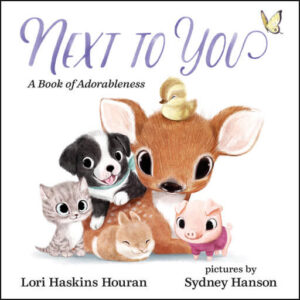 Next to You: A Book of Adorableness
Next to You: A Book of Adorableness
By Lori Haskins Houran
Illustrated by Sydney Hanson
Albert Whitman & Co.
$16.99
ISBN: 9780807556009
Ages 4-7
On shelves now
Years ago I saw a very interesting sketch produced during the early years of Disney animated filmmaking. The drawing was an explanation to animators on the precise proportions it takes to make a drawn character “cute”. The size of the eyes, the proportions between a large head and small hands, the slant of the gaze, all this contributes to the final cute form. At its worst, the word “cute” conjures up creations like those Precious Moments figurines and their insipid equals. At its best, it touches on our maternal and paternal instincts, even if we’re the kinds of folks who prefer furry animals to actual human babies. If you are a children’s librarian working with picture books, you get a nice and steady influx of cute into your location. Some of it is good, but most of it is fairly intolerable. An Anne Geddes / Nancy Tillman-like excess. I can be forgiven then for putting aside Next to You: A Book of Adorableness when first it came to my desk. I read every picture book I’m sent, but some I read a little faster than others, and this didn’t strike me as something to rush over and devour. It took a fellow co-worker to break the news to me that author Lori Haskins Houran’s title has a very sharp tongue lodged firmly in its cheek. With a canniness uncommon in cutesy picture book fair, Next to You manages to reach a dual readership: People who will take it seriously and people who will get the joke. Sweet.
 A narrator addressing a child sets the tone at the start. That tiny border collie puppy with the bow around its next and a little lamb toy (nice touch)? It’s only “kind of cute”. The yawning tiger cub or round-tailed bunny? “Whatever”. Honestly, the person being addressed wipes the floor with the competition. Those animals used to be really cute. “Until you came along. Now? Sorta so-so”. The narrator’s casual attitude is swiftly called into question, however, when they see a newborn giraffe for the first time. Seeing the giraffe chasing a butterfly, they’re almost persuaded that the giraffe is cuter but, “No! NO WAY! They are NOT as adorable as you. Not NEARLY.” Whew! A final shot of some of the animals in a cuddly pile ends with the narrator saying that none of them are as cute as you, “And you know what? I’m happy to be . . . next to you.” Aw.
A narrator addressing a child sets the tone at the start. That tiny border collie puppy with the bow around its next and a little lamb toy (nice touch)? It’s only “kind of cute”. The yawning tiger cub or round-tailed bunny? “Whatever”. Honestly, the person being addressed wipes the floor with the competition. Those animals used to be really cute. “Until you came along. Now? Sorta so-so”. The narrator’s casual attitude is swiftly called into question, however, when they see a newborn giraffe for the first time. Seeing the giraffe chasing a butterfly, they’re almost persuaded that the giraffe is cuter but, “No! NO WAY! They are NOT as adorable as you. Not NEARLY.” Whew! A final shot of some of the animals in a cuddly pile ends with the narrator saying that none of them are as cute as you, “And you know what? I’m happy to be . . . next to you.” Aw.
Okay. So let’s talk audience here. When a picture book is talking about how cute someone is, that’s usually a tip-off that kids aren’t actually the focus. Instead, this is probably a book written with the hopes of becoming a baby shower staple. Picture books for expectant mothers are big business (how else to explain the inexplicable yet continual sales of Love You Forever?) so each season we see a couple titles make a play for the hearts and minds of incipient parents everywhere. Few succeed in the long run. What distinguishes Next to You from the pack is that it manages to not merely be a new baby book. Houran has somehow or other managed to write something that has appeal to a certain brand of snarky new parent (a common animal too often ignored by the picture book market) AND to actual children as well. This book is self-aware. A saving grace.
 The text gets you pretty much from the first sentence onward. “Next to you, the softest puppy in the world is only kind of cute.” As a librarian I was intrigued but I wasn’t sold. Not until we got to the squirrel. That was the moment when I felt like Houran was making a distinct comment about those of us that waste countless hours watching cute animal videos on YouTube. “A squirrel eating a doughnut with his tiny hands? Adorable, sure. But next to you? Meh. Just OK.” The mix of “tiny hands” and “meh” is noteworthy. I know this sounds a little odd, but that two-page spread is the first true indication that you’re dealing with a picture book is a slick sense of humor. After all, that opening line might just be a fluke. But there is no denying how funny squirrels with itty-bitty widdle hands are, particularly when combined with the all-encompassing and supremely uninterested, “meh”. When the book stops for a moment to goggle at the shockingly cute giraffe, that pause is fascinating. I mean, how do you get a plot out of a book where all the narrator is saying is how cute various animals are? Houran must have also had a blast trying to conjure up all the different forms of cuteness out there? At the same time, take some care to notice that these animals are never in compromising positions. A pig may occasionally wear a sweater but nothing here is considered cute because it’s having its dignity taken away.
The text gets you pretty much from the first sentence onward. “Next to you, the softest puppy in the world is only kind of cute.” As a librarian I was intrigued but I wasn’t sold. Not until we got to the squirrel. That was the moment when I felt like Houran was making a distinct comment about those of us that waste countless hours watching cute animal videos on YouTube. “A squirrel eating a doughnut with his tiny hands? Adorable, sure. But next to you? Meh. Just OK.” The mix of “tiny hands” and “meh” is noteworthy. I know this sounds a little odd, but that two-page spread is the first true indication that you’re dealing with a picture book is a slick sense of humor. After all, that opening line might just be a fluke. But there is no denying how funny squirrels with itty-bitty widdle hands are, particularly when combined with the all-encompassing and supremely uninterested, “meh”. When the book stops for a moment to goggle at the shockingly cute giraffe, that pause is fascinating. I mean, how do you get a plot out of a book where all the narrator is saying is how cute various animals are? Houran must have also had a blast trying to conjure up all the different forms of cuteness out there? At the same time, take some care to notice that these animals are never in compromising positions. A pig may occasionally wear a sweater but nothing here is considered cute because it’s having its dignity taken away.
It’s a lucky editor that gets a manuscript like this one. Imagine knowing that the artist you acquired would have to excel in the art of “cute”. This editor undoubtedly had to consider a wide swath of artists adept at big eyes and tiny bodies. In the end, the selection fell to first time picture book illustrator Sydney Hanson. Trained in animation and character design, Hanson’s Tumblr page is awash in a sea of sweetness. More details and intricate than the characters found in this book, Hanson is adept at not simply rendering cute the horrible (the big-eyed tarantula is my favorite) but making it clear that these characters have personalities too. The book doesn’t give away Hanson’s medium, so this might all be done on a computer for all I know. That said, it looks like colored pencils. For the art to be effective there has to be a certain level of fuzziness to it. Colored pencils provide that virtual fuzz. My two-year-old son has taken to hugging cute characters in books when he sees them. Next to You, thanks to Hanson’s techniques, is now infinitely huggable.
I never thought I’d say this, but I think this book would actually make a good readaloud to a large group. It would take some practice. You’d really have to get your cadences down. But with the right inflection this could actually work for a bunch of kids. It might even work particularly well for those of the jaded variety. The same kinds of kids that get hornswaggled by Guess Again! by Mac Barnett and Adam Rex would find themselves flummoxed by this book. Few can turn pages without thinking, “Where is this going?” An oddity of a book, but a good one to know about. Don’t let the big blue kitten eyes on the cover fool you. There’s a lot to love between these pages. It’s a book that upsets expectations for adults but still manages to be fun for kids. And if you happen to want to give it to a new parent, I’m not gonna stop you. Not one little bit.
On shelves now.
Like This? Then Try:


By:
Betsy Bird,
on 4/28/2016
Blog:
A Fuse #8 Production
(
Login to Add to MyJacketFlap)
JacketFlap tags:
picture books,
Harper Collins,
Best Books,
Katherine Tegen Books,
Brendan Wenzel,
preschool storytime readalouds,
picture book readalouds,
Best Books of 2016,
2016 picture books,
2016 reviews,
Reviews 2016,
2016 picture book readalouds,
Daniel Bernstrom,
Reviews,
Add a tag
 One Day in the Eucalyptus, Eucalyptus Tree
One Day in the Eucalyptus, Eucalyptus Tree
By Daniel Bernstrom
Illustrated by Brendan Wenzel
Katherine Tegen Books (an imprint of Harper Collins)
$17.99
ISBN: 978-0-06-235485-3
Ages 3-6
On shelves May 3rd
Like any children’s librarian, I like to assess each picture book that crosses by my eyeballs for readaloud potential. While every picture book (even the wordless ones) can be read aloud to a large group of children, only a select few thrive in that environment. It takes a certain magical combination of art and text to render a story readaloud-perfect. Books you can sing have a leg up. Ditto books with flaps or pull-tabs. But the nice thing about Bernstrom’s book One Day in the Eucalyptus, Eucalyptus Tree is that it doesn’t need to rely on those extra features to enrapture an audience. The book’s lilting rhymes, when practiced beforehand, have the potential to render an audience entranced. Add in the art of Brendan Wenzel, and how well it reads across a room, and you’ve got yourself the makings of what might possibly be the best readaloud picture book of the year.
A boy and his whirly-twirly toy are just the first things to disappear down the gullet of a hungry yellow snake. But rather than bemoan his fate, the boy gets to work in his new role as the snake’s inner id. Commenting on the sheer amount of room and space in the belly, the boy cajoles the snake into eating more and more and more. From birds and worms, to mossy sloths, to a single apple bearing a tiny fly, the creatures slide down the snake’s rapidly expanding throat. A final meal proves too much for the voracious viper and next thing you know boy, toy, and a host of other animals are upchucked back into the world from whence they came. A sly illustration at the end suggests that history may repeat itself soon.
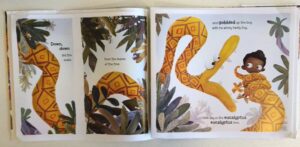 It’s not as if Mr. Bernstrom is the first person to find the word “eucalyptus” so exceedingly delicious to both tongue and ear, but he certainly seems to have been the most prominent in recent memory. As I read the book the language of the reading triggered something in my brain. Something long forgot. And though his name evokes strong feelings in every possible direction, it was Rudyard Kipling I thought of as I read this tale. Specifically the tale of “How the Elephant Got His Trunk”. Though that story does not realize how superb the word “eucalyptus” is when repeated, Kipling got a great deal of mileage out of illustrating thoughts with words. Terms like “great grey greasy Limpopo river”, “Kolokolo Bird”, and “the Bi-Coloured-Python-Rock-Snake” make those of us reading the stories aloud sound good. Bernstrom is writing for a younger audience so he doesn’t flex his muscles quite as far as Kipling did, but at the same time you recognize that he has the potential to do so. One hopes his future publishing plans may include longer stories just meant for sharing aloud. Lord knows we need more authors like that these days.
It’s not as if Mr. Bernstrom is the first person to find the word “eucalyptus” so exceedingly delicious to both tongue and ear, but he certainly seems to have been the most prominent in recent memory. As I read the book the language of the reading triggered something in my brain. Something long forgot. And though his name evokes strong feelings in every possible direction, it was Rudyard Kipling I thought of as I read this tale. Specifically the tale of “How the Elephant Got His Trunk”. Though that story does not realize how superb the word “eucalyptus” is when repeated, Kipling got a great deal of mileage out of illustrating thoughts with words. Terms like “great grey greasy Limpopo river”, “Kolokolo Bird”, and “the Bi-Coloured-Python-Rock-Snake” make those of us reading the stories aloud sound good. Bernstrom is writing for a younger audience so he doesn’t flex his muscles quite as far as Kipling did, but at the same time you recognize that he has the potential to do so. One hopes his future publishing plans may include longer stories just meant for sharing aloud. Lord knows we need more authors like that these days.
The story itself sounds familiar when you read it, but that may have to do more with familiar tropes than a tale we’ve actually seen done. The book also taps into a very popular method of extracting eaten creatures from predators’ bellies: burping. Vomiting works too, though the word sounds more disgusting, so usually in cases like this book the critters are released in a big old burp. In this case, we’re basically seeing a nature-based version of that Monty Python skit where the diner is persuaded to eat one final item (“It’s wafer-thin”). It’s odd to enjoy so much a book where a kid tricks the animal it is within to throw up, but there you go. The storytelling itself is top notch too, though I had a moment of confusion when the snake ate the beehive. Seems to me that that moment is where the boy’s plan potentially takes a turn south. Being stuck in a snake’s belly is one thing. Being stuck in a snake’s belly with flying, stinging insects? Thanks but no.
 Illustrator Brendan Wenzel burst onto the children’s picture book illustration scene in 2014 but his rise in prominence since that time has been slow. The artist first caught everyone’s eye when he illustrated Angela DiTerlizzi’s Some Bugs but it was the cover art of Ellen Jackson’s Beastly Babies the following year that was the most eye-catching. That cover sold that book. An ardent conservationist, it makes a lot of sense to turn to Wenzel when you’ve a story chock full of sloths, snakes, and bees. With Bernstrom’s tale, Wenzel must render this tale in the style of There Was an Old Lady Who Swallowed a Fly. Which is to say, he needs to balance horror with humor. Books where the protagonist gets eaten are common. Books where the protagonist gets eaten and then continues to comment on the action are rare. Wenzel’s snake falls into that category of villains that must be vicious enough to serve as a legitimate threat, but tame enough that a four-year-old won’t fear them on sight. To do this, Wenzel’s art takes on a distinctly jovial tone that treads towards the cartoonish without ever falling in completely. The colors are bright but not overwhelming, just as the action is consistent without horrifying the audience. Most of the creatures handle being eaten with gentle good grace (though the sloth looks more than a little put out about the whole thing).
Illustrator Brendan Wenzel burst onto the children’s picture book illustration scene in 2014 but his rise in prominence since that time has been slow. The artist first caught everyone’s eye when he illustrated Angela DiTerlizzi’s Some Bugs but it was the cover art of Ellen Jackson’s Beastly Babies the following year that was the most eye-catching. That cover sold that book. An ardent conservationist, it makes a lot of sense to turn to Wenzel when you’ve a story chock full of sloths, snakes, and bees. With Bernstrom’s tale, Wenzel must render this tale in the style of There Was an Old Lady Who Swallowed a Fly. Which is to say, he needs to balance horror with humor. Books where the protagonist gets eaten are common. Books where the protagonist gets eaten and then continues to comment on the action are rare. Wenzel’s snake falls into that category of villains that must be vicious enough to serve as a legitimate threat, but tame enough that a four-year-old won’t fear them on sight. To do this, Wenzel’s art takes on a distinctly jovial tone that treads towards the cartoonish without ever falling in completely. The colors are bright but not overwhelming, just as the action is consistent without horrifying the audience. Most of the creatures handle being eaten with gentle good grace (though the sloth looks more than a little put out about the whole thing).
The idea of being eaten whole is as old as “Little Red Riding Hood”. Heck, it’s even older than that. Look at the Greek myths of Cronus devouring his children whole. Look at any myth or legend that talks of children springing unharmed or fully formed from within nasty beasties. Together, Bernstrom and Wenzel take this ancient idea and turn it into a trickster tale. Usually it’s the eater doing the tricking, and not the eaten, but One Day in the Eucalyptus Eucalyptus Tree isn’t afraid to shake things up (or, for that matter, swallow them down). An oddly peppy little tale of surviving through another’s hubris, this is bound to become one of those readaloud picture books that teachers and librarians lean heavily on for decades to come. Look out, Bernstrom and Wenzel. You guys just went and created for yourselves a masterpiece.
On shelves May 3rd.
Source: F&G sent from publisher for review.
Like This? Then Try:
Professional Reviews:


By:
Betsy Bird,
on 3/30/2016
Blog:
A Fuse #8 Production
(
Login to Add to MyJacketFlap)
JacketFlap tags:
Reviews,
Best Books,
Carolrhoda Books,
multicultural children's literature,
Vaunda Micheaux Nelson,
multicultural picture books,
Lerner Publishing Group,
Elizabeth Zunon,
African-American books,
Best Books of 2016,
2016 picture books,
2016 reviews,
Reviews 2016,
Add a tag
 Don’t Call Me Grandma
Don’t Call Me Grandma
By Vaunda Micheaux Nelson
Illustrated by Elizabeth Zunon
Carolrhoda Books (a division of Lerner)
$19.99
ISBN: 978-1-4677-4208-5
Ages 4-7
On shelves now.
In 2016 a picture book won a Newbery Award. Which is to say, a picture book was declared the best-written work for children between the ages of 0-14. After its win there was a fair amount of speculation about what precisely the Newbery committee was trying to say with their award. For that matter, there was a fair amount of speculation about what it meant for children’s literature in general. Are we, as a people, less tolerant of loquacious books? Considering the fact that a book with 592 pages was a runner-up, I think we’re doing just fine in terms of wordy titles. Just the same, I hope that if anything comes out of this surprise award it’s a newfound appreciation for the picture book’s art of restraint. A good picture book shows but doesn’t tell. Don’t believe me? Read the original manuscript of Sendak’s Where the Wild Things Are where he spells everything out for the reader. All these thoughts were in my head recently when I read the remarkable Don’t Call Me Grandma by Vaunda Micheaux Nelson. Tackling the almost nonexistent subcategory of grouchy great-grandparents, Ms. Nelson deftly encapsulates a woman’s personality and lifetime of experiences in a scant 32 pages.
“Great-grandmother Nell is scary.” You got that right, kid. She also does not hug, or kiss, or chase her great-grandchild for fun. Instead she sips an intoxicating beverage from a glass bedecked with a spider. She serves up fish for breakfast, buggy eyes and all. But she also has a vanity full of mysterious perfumes, lipstick as red as rubies, and memories as sharp and painful as the day they were made. And when her great-granddaughter sneaks a kiss, Nell is still scary. But that’s okay. “…I like her that way.”
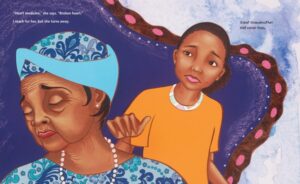 First and foremost, this is not a fuzzy grandparent (or great-grandparent) book. There are plenty of fuzzy books out there, filled to brimming with warm snuggly feelings. If that is the kind of book you require then grab yourself the nearest Nancy Tillman and content yourself accordingly. What we have here instead is a kind of character study. Whatever expectations you carry into this book, they will be upended by the text. Nell is an amazing character, one that I’ve never seen in book of this sort. Her prickly nature may well hide that “broken heart” she mentions obliquely, but it could just as easily hide more prickles. We get three distinct memories of her past, but it’s a single wordless two-page spread that probably says more about her than anything else. As an adult, I found myself speculating about her life. How perhaps she had dreams of dancing professionally but that she put those dreams aside when she had her children at a very young age. No kid is going to read into Nell what I have. That’s what makes reading this book so dynamic. Come for the prickly relative. Stay for the enticing, unknowable back story.
First and foremost, this is not a fuzzy grandparent (or great-grandparent) book. There are plenty of fuzzy books out there, filled to brimming with warm snuggly feelings. If that is the kind of book you require then grab yourself the nearest Nancy Tillman and content yourself accordingly. What we have here instead is a kind of character study. Whatever expectations you carry into this book, they will be upended by the text. Nell is an amazing character, one that I’ve never seen in book of this sort. Her prickly nature may well hide that “broken heart” she mentions obliquely, but it could just as easily hide more prickles. We get three distinct memories of her past, but it’s a single wordless two-page spread that probably says more about her than anything else. As an adult, I found myself speculating about her life. How perhaps she had dreams of dancing professionally but that she put those dreams aside when she had her children at a very young age. No kid is going to read into Nell what I have. That’s what makes reading this book so dynamic. Come for the prickly relative. Stay for the enticing, unknowable back story.
What I would really like to praise in this review, if nothing else, is just how deftly author Vaunda Micheaux Nelson parses words into sentences that swell with meaning. Take, for example, the moment when our heroine enters Great-Grandmother Nell’s bedroom. She considers playing with the cloth ballerina on the best but abstains, saying, “her expression makes me think she might tell.” Later she kisses her great-grandmother in her sleep. “Even asleep, Great-Grandmother Nell is scary. But I like her that way.” The very last line? “She won’t know”. It would be fascinating to see Nelson’s original manuscript. Was it just this sparse and spare? Or was it much longer and cut down to the bone in the editing process? Whichever it was, it works.
 The child in this book is much like the child who will be reading it with an adult. Both she and they sense that there is more at work here than meets the eye. And it is the art by Elizabeth Zunon that backs that feeling up. Elizabeth Zunon has been a force to reckon with for years. I first noticed her when she illustrated William Kamkwamba’s The Boy Who Harnessed the Wind, though I unknowingly had already been a fan of hers when she illustrated Jeanne Harvey’s My Hands Sing the Blues. In Don’t Call Me Grandma she begins with a straightforward contemporary story. Even then, her endpapers start telling the tale long before the words do (not counting the title). She fills these early pages with strings of pearls. Fat pearls, small pearls, pink and gray and white pearls. Note that in the text there is just one mention of those pearls, and it’s in the context of a lot of other things on Nell’s dressing table. But Zunon is getting a grip on her personality in her own way. Because of her we get a distinct sense of Great-Grandmother’s style, poise, and dignity. There are fun little details too, like the family peering out through the window as Nell gives a singing bird what for and how to. Zunon also lends Nell a humanity on the sidelines. When her great-granddaughter looks around her room we see Nell observing affectionately from the sides (though she’d be the first to deny it if you accosted her with the evidence). Then there are the memories. Depicted as splotchy watercolors, Zunon subtly changes her style to indicate how some memories are crystal clear even as they blur and go soft around the edges. The two-page spread of objects representing other memories (everything from photographs of Civil Rights marchers to tickets to an Alvin Ailey ballet) will require giving child readers some context. Nothing wrong with that. Sit them down and explain each thing you see. Don’t recognize something? Look it up!
The child in this book is much like the child who will be reading it with an adult. Both she and they sense that there is more at work here than meets the eye. And it is the art by Elizabeth Zunon that backs that feeling up. Elizabeth Zunon has been a force to reckon with for years. I first noticed her when she illustrated William Kamkwamba’s The Boy Who Harnessed the Wind, though I unknowingly had already been a fan of hers when she illustrated Jeanne Harvey’s My Hands Sing the Blues. In Don’t Call Me Grandma she begins with a straightforward contemporary story. Even then, her endpapers start telling the tale long before the words do (not counting the title). She fills these early pages with strings of pearls. Fat pearls, small pearls, pink and gray and white pearls. Note that in the text there is just one mention of those pearls, and it’s in the context of a lot of other things on Nell’s dressing table. But Zunon is getting a grip on her personality in her own way. Because of her we get a distinct sense of Great-Grandmother’s style, poise, and dignity. There are fun little details too, like the family peering out through the window as Nell gives a singing bird what for and how to. Zunon also lends Nell a humanity on the sidelines. When her great-granddaughter looks around her room we see Nell observing affectionately from the sides (though she’d be the first to deny it if you accosted her with the evidence). Then there are the memories. Depicted as splotchy watercolors, Zunon subtly changes her style to indicate how some memories are crystal clear even as they blur and go soft around the edges. The two-page spread of objects representing other memories (everything from photographs of Civil Rights marchers to tickets to an Alvin Ailey ballet) will require giving child readers some context. Nothing wrong with that. Sit them down and explain each thing you see. Don’t recognize something? Look it up!
A woman of my acquaintance used to make a big show of objecting to any and all picture books that depicted grandmothers as white-haired, doddering old women, tottering on the very edge of the grave. To her mind, there should be at least as many books that show those women as resourceful, spry, and full of energy. Great-Grandmothers probably have few books where they’re wrecking havoc with the universe. Generally speaking they just dodder and die. There will be no doddering and certainly no dying in Don’t Call Me Grandma, though. Nell isn’t just a character. She comes off the page like a full-blown human being, warts and all (just an expression – Nell would take me to the cleaners if she heard me indicating she has any warts). Sharp and smart, this is one of those picture books I’d like to see more of. Which is to say, stories I’ve never seen before.
On shelves now.
Source: Final copy sent from publisher for review.
Like This? Then Try:
Professional Reviews:


By:
Betsy Bird,
on 3/1/2016
Blog:
A Fuse #8 Production
(
Login to Add to MyJacketFlap)
JacketFlap tags:
Reviews,
picture books,
Simon and Schuster,
Atheneum,
Best Books,
Evan Turk,
Best Books of 2016,
2016 picture books,
2016 reviews,
Reviews 2016,
original folktale,
Add a tag
 The Storyteller
The Storyteller
By Evan Turk
Atheneum (an imprint of Simon & Schuster)
$24.99
ISBN: 9781481435185
Ages 4-8
On shelves June 28th
Credit the internet age for doing what the television age never could. I don’t know if you’ve noticed, but there is a movement around the world that can be interpreted as nothing so much as a direct response to our digital age. You may have noticed it in small things, like the rise of Steampunk or the sudden surge of interest in Maker stations and the kinds of “hacking” that look suspiciously similar to activities found in shop class in days of yore. All this comes about because people have come to believe that we do not create enough tangible objects in our day-to-day lives anymore. And while this is true, let us not forget that we do not create enough intangible objects either. I’m talking about storytelling, that ancient artform that is currently seeing a worldwide resurgence. It isn’t just the increase in storytelling festivals and podcasts like The Moth here in the States. Young people in countries worldwide are doing what their elders have desired for decades; they’re asking to be told a story. Taking his cues from the newfound interest of young Moroccans in Marrakech in the ancient storytelling tradition, author/illustrator Evan Turk uses the folktale format to craft an original story about storytelling, weaving, history, and language. The end result is a twisty turny story within a story within a story that challenges young readers even as it lures them in.
Once, in the great country of Morocco, storytellers flourished and the cities’ fountains flowed with cool, clear water. As time went on the people became comfortable and forgot about the storytellers, and so they disappeared over the years. So too did the fountains dry up, until one day a boy went looking for some water. What he found instead was an old storyteller. As the man told his tale he would end his story with a story within a story and the boy would find his brass cup filled with liquid. Even as this was happening, however, a desert djinn saw the drought as an opportunity to reclaim the cities that had previously held him back with their fountains. Yet when the djinn was set to level his town, the boy managed to delay him with his storytelling. And as he wove his tale, the people were able to refill their fountains until finally storytelling and water ran freely in the cities once more.
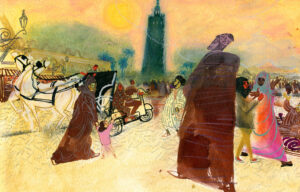 My brain is not what it used to be. Remind me again. What’s that term for a story that tells a story that tells a story that ends only when the innermost story doubles back and each tale is finished in turn? Is there a word such a thing? I suspect that the storytellers amongst us would know. The most obvious similarity to this book that comes to mind is, of course, the tale of Scheherazade. Indeed, the boy uses his stories to trick the djinn. And what could be a more natural comparison? In both tales it is storytelling that proves to be the saving of us all. Our thirst is quenched and we are tied to our history like never before. The obvious question then is whether or not Turk’s text is too complex for kids to follow. Sure, he distinguishes between the tales with different colored fonts, but will that be enough to allow them to remember what came before as they plunge deeper and deeper into the narrative? I think there may be some confusion at work, certainly. I wouldn’t necessarily hand this to a three or four-year-old. However, Turk’s text takes pains to remind the reader where the tale was before. The art helps as well. Confusion, such as it is, will be held to a minimum.
My brain is not what it used to be. Remind me again. What’s that term for a story that tells a story that tells a story that ends only when the innermost story doubles back and each tale is finished in turn? Is there a word such a thing? I suspect that the storytellers amongst us would know. The most obvious similarity to this book that comes to mind is, of course, the tale of Scheherazade. Indeed, the boy uses his stories to trick the djinn. And what could be a more natural comparison? In both tales it is storytelling that proves to be the saving of us all. Our thirst is quenched and we are tied to our history like never before. The obvious question then is whether or not Turk’s text is too complex for kids to follow. Sure, he distinguishes between the tales with different colored fonts, but will that be enough to allow them to remember what came before as they plunge deeper and deeper into the narrative? I think there may be some confusion at work, certainly. I wouldn’t necessarily hand this to a three or four-year-old. However, Turk’s text takes pains to remind the reader where the tale was before. The art helps as well. Confusion, such as it is, will be held to a minimum.
I first knew of Turk’s work when he illustrated Bethany Hegedus’s Grandfather Gandhi. In that book he integrated real spun cotton threads into the art, knowing full well the importance spinning had to Gandhi and his followers. In this book, weaving is the craft of choice so I wondered, not without reason, if woven threads would make their way into the art. As it happens, there are plenty of water-soluble crayons, colored drawing pencils, inks, indigo, sugared green tea, and even art created by heat gun and fire in the illustrations, but nothing so simple as thread. Turk mentions this on his publication page and he puts a little note to the reader there as well. It reads, “Look for a blue glimmer of hope to appear around each story!” and a small blue diamond appears. Naturally, I was curious so I looked. Sure as shooting, after each story’s text a diamond appears. However, as the stories appear within stories within stories, the diamonds grow more elaborate and decorative. Then, as the stories end one by one, the diamonds simplify once more. I began searching the art for more diamonds and here Turk doesn’t disappoint. If you look closely at the borders of the book, you see that the diamonds appear when there is hope and fade from blue to brown diamonds when hope dries up. As the storytelling increases the borders fill in more and more blue, just as the townspeople fill their fountains with bowl after bowl of water. Point out to a child reader the diamond motif and you are sure to be surprised by all that they find hidden in these pages.
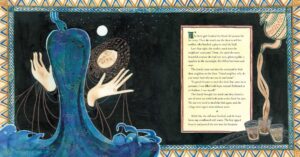 I should probably say something about Turk’s art itself. When I reviewed Grandfather Gandhi I had difficulty putting into words precisely what Turk does with his images. So I looked at the book’s professional reviews. His art causes reviewers to use terms like “dynamic visuals”, “stylized” and “strikingly patterned”. They say his art displays “bold, expressive imagery” or that he “mixes carefully detailed renderings with abstracted expressions of emotional struggle.” I agree with all of that but no one mentions his faces and hands. The patterns here are striking and upon closer inspection they yield such marvelous details it wouldn’t take much for this art to spin wildly out of control, opting for an abstract approach to the proceedings as a whole. Instead, Turk centers his art through the hands and faces of his characters. Look closely and you’ll see what I mean. The old storyteller’s hands are gnarled and wonderfully expressive, even as his audience of one clutches a single brass bowl. The hands of a cunning neighbor stroke her child as she schemes, while a princess, escaping on the night before her wedding, holds up her hennaed hands in despair. Hands. Heads. Hearts.
I should probably say something about Turk’s art itself. When I reviewed Grandfather Gandhi I had difficulty putting into words precisely what Turk does with his images. So I looked at the book’s professional reviews. His art causes reviewers to use terms like “dynamic visuals”, “stylized” and “strikingly patterned”. They say his art displays “bold, expressive imagery” or that he “mixes carefully detailed renderings with abstracted expressions of emotional struggle.” I agree with all of that but no one mentions his faces and hands. The patterns here are striking and upon closer inspection they yield such marvelous details it wouldn’t take much for this art to spin wildly out of control, opting for an abstract approach to the proceedings as a whole. Instead, Turk centers his art through the hands and faces of his characters. Look closely and you’ll see what I mean. The old storyteller’s hands are gnarled and wonderfully expressive, even as his audience of one clutches a single brass bowl. The hands of a cunning neighbor stroke her child as she schemes, while a princess, escaping on the night before her wedding, holds up her hennaed hands in despair. Hands. Heads. Hearts.
There’s been a lot of discussion lately about diversity in children’s literature. Specifically, some of that discussion has concerned those books written by white people about other cultures. It’s not a new phenomenon but what is a bit new is the increasing understanding that if you are going to use another culture, you need to do your homework. If, for example, you are setting a story in Morocco, then you need to make the readers understand why you made that choice. That it wasn’t arbitrary. This is yet another of the many reasons I’m so impressed with Turk’s work here. That he sets his story in Morocco (contemporary Morocco, by the look of it) is deeply purposeful. The Author’s Note at the end explains further. From this we learn that Morocco’s public storytellers or hlaykia have told tales for “nearly one thousand years” and yet “Only a handful of master storytellers remain”. All is not lost, though. Renewed interest in storytelling has surfaced, specifically at a restaurant called Café Clock in Marrakech. Turk then closes with a small Bibliography of sources on everything from storytelling to carpet weaving. The book then is not an appropriation of an “exotic” culture done on a whim but rather a considered, thoughtful selection that serves as an ideal setting for a tale about storytelling then, now, and in the future.
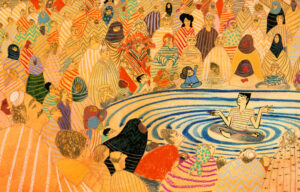 It was once part of a children’s librarian’s training to know how to tell a story from memory. Here in America it was even considered part of a children’s librarian’s heritage, though in the last few decades it has been fast forgotten. There are still pockets that remember, though. That’s why books like Turk’s give me the oddest little sense of hope. As I mentioned before, storytelling everywhere is seeing renewed interest. It seems odd to say, but this book, wrapped as it is in classic motifs and themes dating back hundreds, even thousands, of years, is one of the freshest, most timely picture books I’ve had the honor to read in a long time. Visually stunning with a storyline to match, Turk is beginning to make good on his talents. This is a man with storytelling in his blood and bones. Our children reap the rewards. A can’t miss book.
It was once part of a children’s librarian’s training to know how to tell a story from memory. Here in America it was even considered part of a children’s librarian’s heritage, though in the last few decades it has been fast forgotten. There are still pockets that remember, though. That’s why books like Turk’s give me the oddest little sense of hope. As I mentioned before, storytelling everywhere is seeing renewed interest. It seems odd to say, but this book, wrapped as it is in classic motifs and themes dating back hundreds, even thousands, of years, is one of the freshest, most timely picture books I’ve had the honor to read in a long time. Visually stunning with a storyline to match, Turk is beginning to make good on his talents. This is a man with storytelling in his blood and bones. Our children reap the rewards. A can’t miss book.
On shelves June 28th.
Source: F&G sent from publisher for review.
Like This? Then Try:
- Frederick by Leo Lionni
- Tell Me the Day Backwards by Albert Lamb, ill. David McPhail
- The Girl Who Saved Yesterday by Julius Lester, ill. Carl Angel
Misc:
See more images from the book here.


By:
Betsy Bird,
on 2/14/2016
Blog:
A Fuse #8 Production
(
Login to Add to MyJacketFlap)
JacketFlap tags:
issue picture books,
Julie Pearson,
Pajama Press,
translated picture books,
Reviews,
Canadian children's books,
Canadian picture books,
Manon Gauthier,
international children's books,
diverse picture books,
2016 picture books,
Reviews 2016,
Add a tag
 Elliot
Elliot
By Julie Pearson
Translated by Erin Woods
Illustrated by Manon Gauthier
Pajama Press
$16.95
ISBN: 978-1-927485-85-9
Ages 4-7
On shelves April 4th
The librarian and the bookseller face shelving challenges the like of which you wouldn’t believe. You think all picture books should simply be shelved in the picture book section by the author’s last name and that’s the end of it? Think again. If picture books served a single, solitary purpose that might well be the case. But picture books carry heavy burdens, far above and beyond their usual literacy needs. People use picture books for all sorts of reasons. There are picture books for high school graduates, for people to read aloud during wedding ceremonies, for funerals, and as wry adult jokes. On the children’s side, picture books can help parents and children navigate difficult subjects and topics. From potty training to racism, complicated historical moments and new ways of seeing the world, the picture book has proved to be an infinitely flexible object. The one purpose that is too little discussed but is its most complicated and complex use is when it needs to explain the inexplicable. Cancer. Absentee parents. Down syndrome. Explaining just one of these issues at a time is hard. Explaining two at one time? I’d say it was almost impossible. Julie Pearson’s book Elliot takes on that burden, attempting to explain both the foster system and children with emotional developmental difficulties at the same time. It works in some ways, and it doesn’t work in others, but when it comes to the attempt itself it is, quite possibly, heroic.
Elliot has a loving mother and father, that much we know. However, for whatever reason, Elliot’s parents have difficulty with their young son. When he cries, or yells, or misbehaves they have no idea how to handle these situations. So the social worker Thomas is called in and right away he sets up Elliot in a foster home. There, people understand Elliot’s needs. He goes home with his parents, after they learn how to take care of him, but fairly soon the trouble starts up again. This time Thomas takes Elliot to a new foster care home, and again he’s well tended. So much so that even though he loves his parents, he worries about going home with them. However, in time Thomas assures Elliot that his parents will never take care of him again. And then Thomas finds Elliot a ‘forever” home full of people who love AND understand how to take care of him. One he never has to leave.
 Let me say right here and now that this is the first picture book about the foster care system, in any form, that I have encountered. Middle grade fiction will occasionally touch on the issue, though rarely in any depth. Yet in spite of the fact that thousands and thousands of children go through the foster care system, books for them are nonexistent. Even “Elliot” is specific to only one kind of foster care situation (children with developmental issues). For children with parents who are out of the picture for other reasons, they may take some comfort in this book, but it’s pretty specific to its own situation. Pearson writes from a place of experience, and she’s writing for a very young audience, hence the comforting format of repetition (whether we’re seeing Elliot’s same problems over and over again, or the situation of entering one foster care home after another). Pearson tries to go for the Rule of Three, having Elliot stay with three different foster care families (the third being the family he ends up with). From a literary standpoint I understand why this was done, and I can see how it reflects an authentic experience, but it does seem strange to young readers. Because the families are never named, their only distinguishing characteristics appear to be the number of children in the families and the family pets. Otherwise they blur.
Let me say right here and now that this is the first picture book about the foster care system, in any form, that I have encountered. Middle grade fiction will occasionally touch on the issue, though rarely in any depth. Yet in spite of the fact that thousands and thousands of children go through the foster care system, books for them are nonexistent. Even “Elliot” is specific to only one kind of foster care situation (children with developmental issues). For children with parents who are out of the picture for other reasons, they may take some comfort in this book, but it’s pretty specific to its own situation. Pearson writes from a place of experience, and she’s writing for a very young audience, hence the comforting format of repetition (whether we’re seeing Elliot’s same problems over and over again, or the situation of entering one foster care home after another). Pearson tries to go for the Rule of Three, having Elliot stay with three different foster care families (the third being the family he ends up with). From a literary standpoint I understand why this was done, and I can see how it reflects an authentic experience, but it does seem strange to young readers. Because the families are never named, their only distinguishing characteristics appear to be the number of children in the families and the family pets. Otherwise they blur.
Pearson is attempting to make this accessible for young readers, so that means downplaying some of the story’s harsher aspects. We know that Elliot’s parents are incapable of learning how to take care of him. We are also assured that they love him, but we never know why they can’t shoulder their responsibilities. This makes the book appropriate for young readers, but to withdraw all blame on the parental side will add a layer of fear for those kids who encounter this book without some systematic prepping beforehand. It would be pretty easy for them to say, “Wait. I sometimes cry. I sometimes misbehave. Are my parents going to leave me with a strange family?”
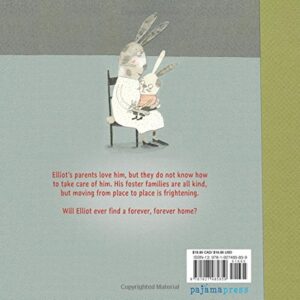 Artist Manon Gauthier is the illustrator behind this book and here she employs a very young, accessible style. Bunnies are, for whatever reason, the perfect animal stand-in for human problems and relationships, and so this serious subject matter is made younger on sight. With this in mind, the illustrator’s style brings with it at least one problematic issue. I suspect that many people that come to this book will approach it in much the same way that I did. My method of reading picture books is to grab a big bunch of them and carry them to my lunch table. Then I go through them and try to figure out which ones are delightful, which ones are terrible, and which ones are merely meh (that would be the bulk). I picked up Elliot and had the reaction to it that I’m sure a lot of people will. “Aw. What a cute little bunny book” thought I. It was around the time Elliot was taken from his family for the second time that I began to catch on to what I was reading. A fellow children’s librarian read the book and speculated that it was the choice of artist that was the problem. With its adorable bunny on the cover there is little indication of the very serious content inside. I’ve pondered this at length and in the end I’ve decided that it’s not the style of the art that’s problematic here but the choice of which image to show on the book jacket. Considering the subject matter, the publisher might have done better to go the The Day Leo Said, ‘I Hate You’ route. Which is to say, show a cover where there is a problem. On the back of the book is a picture of Elliot looking interested but wary on the lap of a motherly rabbit. Even that might have been sufficiently interesting to make readers take a close read of the plot description on the bookflap. It certainly couldn’t have hurt.
Artist Manon Gauthier is the illustrator behind this book and here she employs a very young, accessible style. Bunnies are, for whatever reason, the perfect animal stand-in for human problems and relationships, and so this serious subject matter is made younger on sight. With this in mind, the illustrator’s style brings with it at least one problematic issue. I suspect that many people that come to this book will approach it in much the same way that I did. My method of reading picture books is to grab a big bunch of them and carry them to my lunch table. Then I go through them and try to figure out which ones are delightful, which ones are terrible, and which ones are merely meh (that would be the bulk). I picked up Elliot and had the reaction to it that I’m sure a lot of people will. “Aw. What a cute little bunny book” thought I. It was around the time Elliot was taken from his family for the second time that I began to catch on to what I was reading. A fellow children’s librarian read the book and speculated that it was the choice of artist that was the problem. With its adorable bunny on the cover there is little indication of the very serious content inside. I’ve pondered this at length and in the end I’ve decided that it’s not the style of the art that’s problematic here but the choice of which image to show on the book jacket. Considering the subject matter, the publisher might have done better to go the The Day Leo Said, ‘I Hate You’ route. Which is to say, show a cover where there is a problem. On the back of the book is a picture of Elliot looking interested but wary on the lap of a motherly rabbit. Even that might have been sufficiently interesting to make readers take a close read of the plot description on the bookflap. It certainly couldn’t have hurt.
Could this book irreparably harm a child if they encountered it unawares? Short Answer: No. Long Answer: Not even slightly. But could they be disturbed by it? Sure could. I don’t think it would take much stretch of the imagination to figure that the child that encounters this book unawares without any context could be potentially frightened by what the book is implying. I’ll confess something to you, though. As I put this book out for review, my 4-year-old daughter spotted it. And, since it’s a picture book, she asked if I could read it to her. I had a moment then of hesitation. How do I give this book enough context before a read? But at last I decided to explain beforehand as much as I could about children with developmental disabilities and the foster care system. In some ways this talk boiled down to me explaining to her that some parents are unfit parents, a concept that until this time had been mercifully unfamiliar to her. After we read the book, her only real question was why Elliot had to go through so many foster care families, so we got to talk about that for a while It was a pretty valuable conversation and not one I would have had with her without the prompting of the book itself. So outside of children that have an immediate need of this title, there is a value to the contents.
What’s that old Ranganathan rule? Ah, yes. “Every book its reader.” Trouble is, sometimes the readers exist but the books don’t. Books like Elliot are exceedingly rare sometimes. I’d be the first to admit that Pearson and Gauthier’s book may bite off a bit more than it can chew, but it’s hardly a book built on the shaky foundation of mere good intentions. Elliot confronts issues few other titles would dare, and if it looks like one thing and ends up being another, that’s okay. There will certainly be parents that find themselves unexpectedly reading this to their kids at night only to discover partway through that this doesn’t follow the usual format or rules. It’s funny, strange, and sad but ultimately hopeful at its core. Social workers, teachers, and parents will find it one way or another, you may rest assured. For many libraries it will end up in the “Parenting” section. Not for everybody (what book is?) but a godsend to a certain few.
On shelves April 4th.
Source: Galley sent from publicist for review.


By:
Betsy Bird,
on 1/24/2016
Blog:
A Fuse #8 Production
(
Login to Add to MyJacketFlap)
JacketFlap tags:
macmillan,
Lisa Brown,
Neal Porter Books,
Best Books of 2016,
2016 picture books,
2016 reviews,
Reviews 2016,
Reviews,
Roaring Brook,
Best Books,
picture book reviews,
Add a tag
 The Airport Book
The Airport Book
By Lisa Brown
A Neal Porter Book, Roaring Brook, an imprint of Macmillan
$16.99
ISBN: 978-1-62672-091-6
Ages 4-7
On shelves May 10th.
Look, I don’t wanna brag but I’m what you might call a going-to-the-airport picture book connoisseur. I’ve seen them all. From out-of-date fare like Byron Barton’s Airport to the uniquely clever Flight 1-2-3 by Maria Van Lieshout to the odd but helpful Everything Goes: In the Air by Brian Biggs. Heck, I’ve even examined at length books about the vehicles that drive on the airport tarmac (see: Brian Floca’s Five Trucks). If it helps to give kids a better sense of what flying is like, I’ve seen it, baby. And I will tell you right here and now that not a single one of these books is quite as good at explaining every step of the journey as well as Lisa Brown’s brand new The Airport Book. I’d even go so far as to say that it’s more than just an instructional how-to. Packed with tiny details that make each rereading worthwhile, a plot that sweeps you along, and downright great information, this one here’s a keeper to its core.
“When you go to the airport, you can take a car, a van, a bus, or even a train. Sometimes we take a taxicab.” A family of four prepares for a big trip. Bags are packed with the haste that anyone with small children will recognize. Speed is of the essence. As they arrive at the airport we meet other people and families taking the same flight. There’s airport security to get through (the book mentions the many lines you sometimes have to stand in to get where you’re going), the awesome size of the airport itself, the gate, and then the plane. As we watch the younger sister in the family is having various mild freakouts over her missing (or is it?) stuffed monkey. The monkey in question is always in our view, packed in a suitcase, discovered by a dog during the flight, and finally reuniting with its owner on the luggage carousel. The family meets up with the grandparents and at last the vacation can begin. That is, until they all have to go home again.
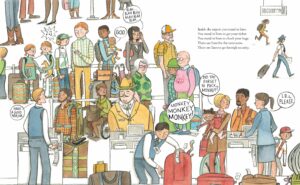 The problem with most airport-related picture books is something I like to call the Fly Away Home conundrum. Originally penned by Eve Bunting, Fly Away Home is one of those rare picture books out there that deal with homelessness in a realistic way. The story features a father and son living out of an airport. Since it touches on such an important, and too little covered, topic, the book continues to appear on required reading lists, in spite of the fact that the very premise is now woefully out-of-date. There are few areas of everyday American life that have changed quite so dramatically over such a short amount of time as the average airport experience. That’s why so many things about The Airport Book rang true for me. When Brown covers the facts surrounding departures and goodbyes to family and friends, she doesn’t set the scene inside the building but rather on the sidewalk outside of ticketing, as people are dropped off. Later you see people at their gate plugging in their cell phones willy-nilly (something I’ve never seen in a picture book before). It lends the book a kind of air of authenticity.
The problem with most airport-related picture books is something I like to call the Fly Away Home conundrum. Originally penned by Eve Bunting, Fly Away Home is one of those rare picture books out there that deal with homelessness in a realistic way. The story features a father and son living out of an airport. Since it touches on such an important, and too little covered, topic, the book continues to appear on required reading lists, in spite of the fact that the very premise is now woefully out-of-date. There are few areas of everyday American life that have changed quite so dramatically over such a short amount of time as the average airport experience. That’s why so many things about The Airport Book rang true for me. When Brown covers the facts surrounding departures and goodbyes to family and friends, she doesn’t set the scene inside the building but rather on the sidewalk outside of ticketing, as people are dropped off. Later you see people at their gate plugging in their cell phones willy-nilly (something I’ve never seen in a picture book before). It lends the book a kind of air of authenticity.
The story’s good and the art’s great but what I liked about the book was the language. Brown never tells you precisely what is going to happen, but she does mention the likelihoods. “Sometimes the plane is bouncy, but most of the time it is smooth.” “Sometimes the sidewalks and staircases move by themselves.” “Sometimes there are small beeping cars driving through . . .” As you read, you realize that in a way the narration of the book is being created for us from the perspective of the big brother. He’ll occasionally insert little notes that are probably of more use to him than us. Example: “You have to hold your little sister’s hands tight, or she could get lost.” Mind you, some of the sections have the ring of poetry to them, while staying squarely within a believable child’s voice. I was particularly fond the of the section that says, “Outside there are clouds and clouds and clouds.”
 With all the calls for more diverse picture books to be published, it would be noticeable if Ms. Brown’s book didn’t have a variety of families, races, ages, genders, etc. What’s notable to me is that she isn’t just checking boxes here. Her diversity far surpasses those books where they’ll throw in the occasional non-white character in a group shot. Instead, the main family has a dark-skinned father and light-skinned, blond mother. Travels through the airport show adults in wheelchairs, twins, women in headscarves, Sikhs, pregnant ladies, and more. In other words, what you’d actually see in an airport these days.
With all the calls for more diverse picture books to be published, it would be noticeable if Ms. Brown’s book didn’t have a variety of families, races, ages, genders, etc. What’s notable to me is that she isn’t just checking boxes here. Her diversity far surpasses those books where they’ll throw in the occasional non-white character in a group shot. Instead, the main family has a dark-skinned father and light-skinned, blond mother. Travels through the airport show adults in wheelchairs, twins, women in headscarves, Sikhs, pregnant ladies, and more. In other words, what you’d actually see in an airport these days.
And then the little details come up. Brown throws into the book a surprising array of tiny look-and-discover elements, suggesting that perhaps this book would be just as much fun in its way as a Where’s Waldo? game for older siblings as it is their younger brethren. Ask them if they can find The Wright Brothers, Hatchet (don’t think too hard about what happens to the plane in that book), the mom’s copy of Jack Kerouac’s On the Road, or the person looking for Amelia Earhart (who may not be as difficult to find as you think). There’s also a cast of characters that command your attention like the businesswoman who’s always on her cell phone and the short artist with the mysteriously shaped package.
There’s nothing to say that in five years airports will be just as different to us today as pre-9/11 airports are now. Yet even if our airports start requiring us to hula hoop and dance the Hurly Burly, Brown’s book is still going to end up being the go-to text desperate parents turn to when they need a book that explains to their children what an average airplane flight looks like. It pretty much gets everything right, exceeding expectations. Generally speaking, books that tell kids about what something is like (be it a trip to the dentist or a new babysitter) are pedantic, didactic, dull as dishwater fare. Brown’s book, in contrast, has flare. Has pep. Has a beat and you can dance to it. Like I said, this may be the best dang going-to-the-airport book I can name (though you should certainly check out the others I’m mentioned at the beginning of this review). A treat, it really is. A treat.
On shelves May 10th.
Source: Galley sent from publisher for review.
Like This? Then Try:
Interviews: Miss Marple’s Musings


By:
Betsy Bird,
on 1/7/2016
Blog:
A Fuse #8 Production
(
Login to Add to MyJacketFlap)
JacketFlap tags:
Reviews,
Best Books,
funny picture books,
Sebastian Meschenmoser,
German children's books,
translated picture books,
NorthSouth Books,
German imports,
Best Books of 2016,
2016 imports,
2016 picture books,
2016 reviews,
Add a tag
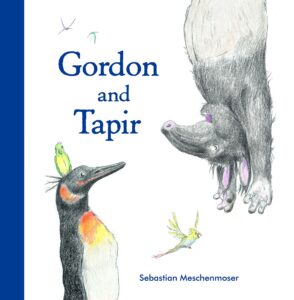 Gordon and Tapir
Gordon and Tapir
By Sebastian Meschenmoser
North/South Books
$18.95
ISBN: 9780735842199
Ages 3-6
On shelves April 1, 2016
There is a perception here in America about the Germans. It is a firm belief that, as a nation, they are devoid of a sense of humor. Americans love to bring this up. I’m not sure what they’re trying to prove necessarily when they say it, but the idea has been repeated so often that few would bother to contest it. Can you name any German stand-up comics? How about funny imported German films? What about funny German picture books? AH HA! There I’ve got you. Because while I cannot pull out of a hat any comics or movies, what I can do is show you without a sliver of a doubt that thanks to picture books like those of Sebastian Meschenmoser, we have absolute proof that Germans have a distinct and ribald sense of humor. With the release of his latest book in the States, Gordon and Tapir, Meschenmoser plumbs the Odd Couple concept with some distinctive twists of his very own. This is some primo German goofball stuff.
The book opens wordlessly. A penguin goes to his restroom with a newspaper. He reaches for the toilet paper. But what is this? Someone’s used it all up. And not just anyone. The penguin, who goes by the name of Gordon, stamps down the hall to his roommate Tapir’s room. Inside he finds the animal reclining in a toilet paper constructed hammock, an elaborate fruit cup in hand and a headdress that would wow Carmen Miranda on his noggin. Immediately Gordon launches into a litany of transgressions Tapir has engaged in. The floor’s sticky with fruit, the dishes are never done, and why exactly has there been a hippo living in the bathtub for the past few days? Tapir isn’t taking this lying down. He has his own complaints, like why does EVERYTHING have to be so neat and tidy? Why does the garbage have to stink of fish all the time? And why can’t Tapir join Gordon’s all-penguin club? Eventually, Gordon moves out and once Tapir discovers this he gives the bird a call. Turns out, it is a fantastic solution. Now Tapir can be dirty, Gordon can be neat, but they can visit each other and be friends again far better than if they lived together. Happy endings for all.
I’ve always carried the torch for Meschenmoser’s art. From his sleepless animals in Waiting for Winter to his previous penguin dip into surrealism in Learning to Fly the man has a strange kinship with the furry and feathery. So much of the character development in these tales comes from their body language. For example, there’s a spread in this book where Gordon lies in bed on his back staring at the ceiling at 3 a.m. while Tapir does much the same thing, albeit blearily, in his own room. This is followed by a silent film of sorts where Gordon finds a new place to stay in the paper and takes off as Tapir hears the door open and looks up with just the saddest expression in his eyes. Any picture book that dares to go silent for an extended amount of time in the center of the story is being gutsy. It’s not easy to pull off, and Meschenmoser ups the ante (as it were) by rendering everything during those wee hours of the morning in black and white graphite sketches.
 Then there are the little visual details and gags. The humor is sublime here. Meschenmoser is just as comfortable with silent gags (remember, this is coming from the man who made Charlie Chaplin references in the images of Mr. Squirrel and the Moon) as he is with words. Some of the jokes are there for the parents doing the reading. Did you notice the tapir in a bathing suit that bedecks the inside bathroom door? Or the fact that when Gordon stomps from the bathroom to Tapir’s room the wallpaper goes from a pristine fish pattern to paper that’s torn and peeling in large chunks? Did you see that the little cactus that Tapir gives to Gordon as a housewarming present is sitting on his dresser earlier in the book? And did you know that every single one of Gordon’s penguin friends is based on a famous author? I’ve good money riding on the fact that one of them resembles Sigmund Freud. I loved that Gordon has a goldfish swimming in his party drink (a tasty treat for later?). And so tiny you’d probably miss them but worth it every time I notice them is this: mongooses in teeny tiny colorful party hats. Life is sweeter because they are there.
Then there are the little visual details and gags. The humor is sublime here. Meschenmoser is just as comfortable with silent gags (remember, this is coming from the man who made Charlie Chaplin references in the images of Mr. Squirrel and the Moon) as he is with words. Some of the jokes are there for the parents doing the reading. Did you notice the tapir in a bathing suit that bedecks the inside bathroom door? Or the fact that when Gordon stomps from the bathroom to Tapir’s room the wallpaper goes from a pristine fish pattern to paper that’s torn and peeling in large chunks? Did you see that the little cactus that Tapir gives to Gordon as a housewarming present is sitting on his dresser earlier in the book? And did you know that every single one of Gordon’s penguin friends is based on a famous author? I’ve good money riding on the fact that one of them resembles Sigmund Freud. I loved that Gordon has a goldfish swimming in his party drink (a tasty treat for later?). And so tiny you’d probably miss them but worth it every time I notice them is this: mongooses in teeny tiny colorful party hats. Life is sweeter because they are there.
But for all that, the real reason I loved this book as much as I did was that the lesson I took away from it wasn’t American in the slightest. Imagine if a Yank tried writing the same book. Gordon and Tapir would have their differences. They’d have their fight. They’d both spend a sleepless night. Then the next morning Gordon would make a concession, Tapir would make a concession, and they’d work out their differences. And there is nothing wrong with a book about meeting someone halfway. Yet what I loved so much about this book was the fact that it eschewed every rote picture book plot I’d come to expect and went in an entirely new direction. Because honestly, let’s face it, sometimes friends are NOT meant to live together. Couples grow apart, people change, and there are times when you are much closer to someone if they don’t share the same space that you do 24/7. Meschenmoser makes it crystal clear that Gordon and Tapir’s friendship is stronger when Gordon leaves. Now I’m sure some folks will read this as a “stick with your own kind” narrative (after all, tapirs and penguins don’t even occupy the same temperate zones) but I’d argue that their friendship belies that. It isn’t that they don’t vastly enjoy each other’s company. They just need their own personal space at the end of the day, and that is absolutely 100% a-okay.
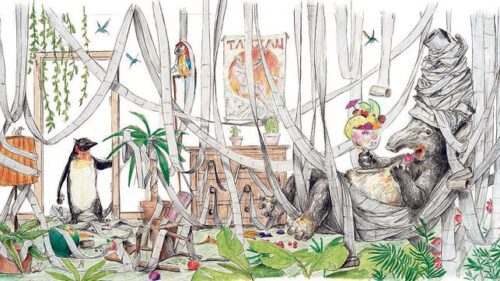 As crazy as it sounds, this actually wouldn’t be the worst picture book to hand to a small child with parents going through a divorce. I think it’s pretty clear from the book that sometimes you have nothing in common with the person you’re living with and that it’s best for all parties if a split is made. I don’t think the book was written with that intention in mind, and that is probably why it would work particularly well. There isn’t any didacticism to plow through. Just good storytelling
As crazy as it sounds, this actually wouldn’t be the worst picture book to hand to a small child with parents going through a divorce. I think it’s pretty clear from the book that sometimes you have nothing in common with the person you’re living with and that it’s best for all parties if a split is made. I don’t think the book was written with that intention in mind, and that is probably why it would work particularly well. There isn’t any didacticism to plow through. Just good storytelling
There’s a long history of funny German children’s literature that leads directly to Mr. Meschenmoser. Remember that this is the country where Der Struwwelpeter came to light (though its humor is a bit of an acquired taste). And alongside fellow contemporary funny German picture book artists like Torben Kuhlmann and Ole Konnecke he’s in good standing. With any luck we’ll be seeing more of their books coming to U.S. shores in the coming years. So who knows? Maybe if we get enough Gordon and Tapir types of books the humorless perception of the German people will undergo a change. At the very least, we’ll get some magnificent stories out of the deal. This one’s a keeper.
On shelves April 1st.
Source: Galley sent from publisher for review.
Like This? Then Try:

 What Color Is the Wind?
What Color Is the Wind? “We can’t see the wind, / we hear what it brings. / We can’t hear the wind, / we see what it brings.” The book begins with a question. A boy, his eyes closed, walks behind the cutout of a house. “What color is the wind? asks the little giant.” As he walks along, various plants, birds, animals, and inanimate objects offer answers. A wolf says the wind’s color is “the dark smell of the forest” while a window disagrees and says it’s “the color of time.” Everything that answers the little giant has a different feel on the page. The stream feels like consecutive ripples emanating from a dropped pebble, the roots of an apple tree like long, thin rivulets. At last the little giant encounters something that he senses is enormous. He asks his question and an enormous giant replies, “It is everything at once. This whole book.” He flips the book’s pages with his thumb so that they fly, and you the reader do the same, feeling the wind the book is capable of producing with its thick, lustrous pages. The color of the wind. The wind of this book.
“We can’t see the wind, / we hear what it brings. / We can’t hear the wind, / we see what it brings.” The book begins with a question. A boy, his eyes closed, walks behind the cutout of a house. “What color is the wind? asks the little giant.” As he walks along, various plants, birds, animals, and inanimate objects offer answers. A wolf says the wind’s color is “the dark smell of the forest” while a window disagrees and says it’s “the color of time.” Everything that answers the little giant has a different feel on the page. The stream feels like consecutive ripples emanating from a dropped pebble, the roots of an apple tree like long, thin rivulets. At last the little giant encounters something that he senses is enormous. He asks his question and an enormous giant replies, “It is everything at once. This whole book.” He flips the book’s pages with his thumb so that they fly, and you the reader do the same, feeling the wind the book is capable of producing with its thick, lustrous pages. The color of the wind. The wind of this book. Obviously my 5-year-old daughter likes the book but she’s just one kid. She is not a representative for her species (so to speak). That said, this book just drills home the advantage that physical books have over their electronic counterparts: the sensation of touch. Play with a screen all day if you like, but you will never be able to move your fingers over these raised dots of rain or the rough bark of a tree’s trunk. As children become more immersed in the electronic, they become more enamored of tactile books. The sensation of paper on skin has yet to be replicated by our smooth as silk screens. And this will prove true with kids on the younger end of the scale. I’ll agree with Kirkus about the adult designation, though. When I worked for New York Public Library there was a group of special needs adults that would come in that were in need of tactile picture books. We would be asked if we had any on hand that we could hand over to them in some way. There were a few, but our holdings were pretty limited (though I do remember a particularly keen tactile version of The Very Hungry Caterpillar that proved to be a big hit). Those kids would have loved this book, but children of all ages, and all abilities, would feel the same way about it. Kids are never too old for tactile picture books. As such, you could use this book with Kindergartners as well as fifth graders. Little kids will like the fun pictures. Older kids may be inspired by the words as well.
Obviously my 5-year-old daughter likes the book but she’s just one kid. She is not a representative for her species (so to speak). That said, this book just drills home the advantage that physical books have over their electronic counterparts: the sensation of touch. Play with a screen all day if you like, but you will never be able to move your fingers over these raised dots of rain or the rough bark of a tree’s trunk. As children become more immersed in the electronic, they become more enamored of tactile books. The sensation of paper on skin has yet to be replicated by our smooth as silk screens. And this will prove true with kids on the younger end of the scale. I’ll agree with Kirkus about the adult designation, though. When I worked for New York Public Library there was a group of special needs adults that would come in that were in need of tactile picture books. We would be asked if we had any on hand that we could hand over to them in some way. There were a few, but our holdings were pretty limited (though I do remember a particularly keen tactile version of The Very Hungry Caterpillar that proved to be a big hit). Those kids would have loved this book, but children of all ages, and all abilities, would feel the same way about it. Kids are never too old for tactile picture books. As such, you could use this book with Kindergartners as well as fifth graders. Little kids will like the fun pictures. Older kids may be inspired by the words as well.























































































































I’m actually delighted that you sometimes use your children as readers. Every now and then I read a bunch of reviews for a book that adults are enchanted by–maybe the illustrations remind them of books when they were younger, or a particular moral is being taught, or the artist is particularly sophisticated and original…I order the book, read it to children, and receive a universal, “Huh?”
Of course there are books that really only work for a few kids, but the universal “Huh?”–where not one hand goes up, asking to check it out–always makes me wish I had my money back. If I had my way, every picture book would be taken to a school or day-care center and tried on kids before it’s published.
Agreed. And it’s been a real blow to my reviews, in a way, that I don’t have daily interactions with large groups of children anymore. In lieu of that I had to make a couple of my own. Still, two is not a representative sample so I hold myself back on using them too too often.